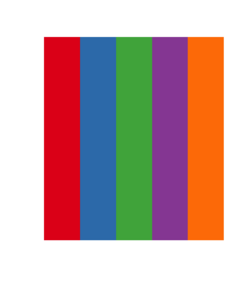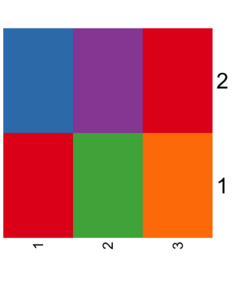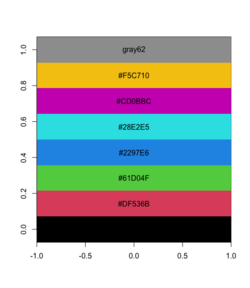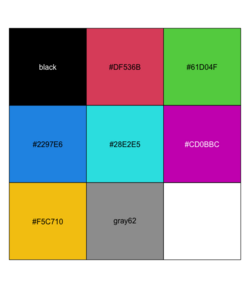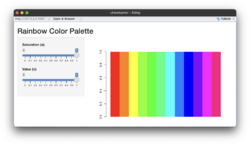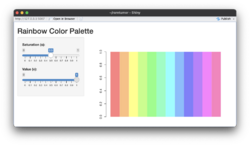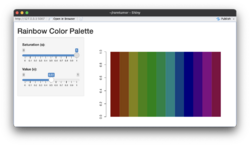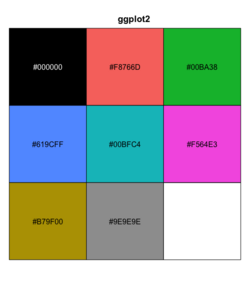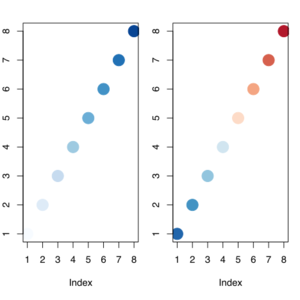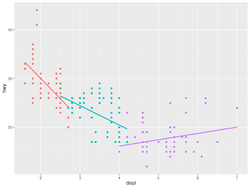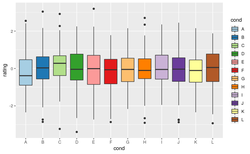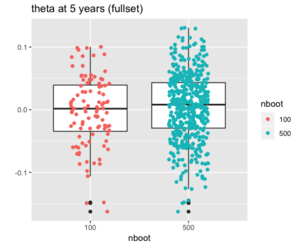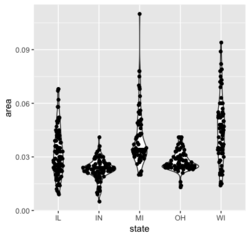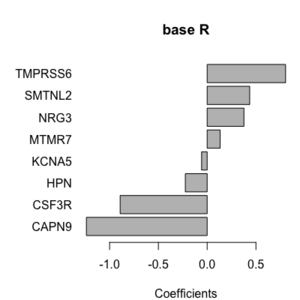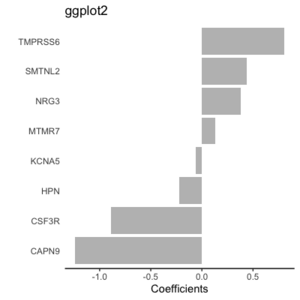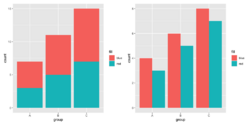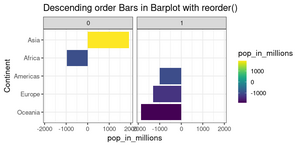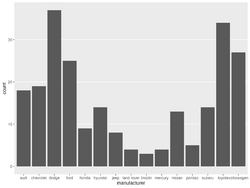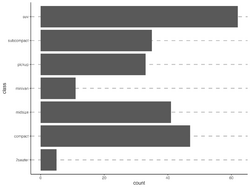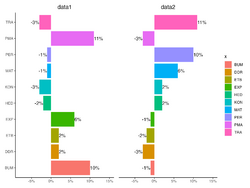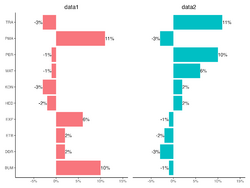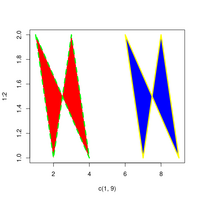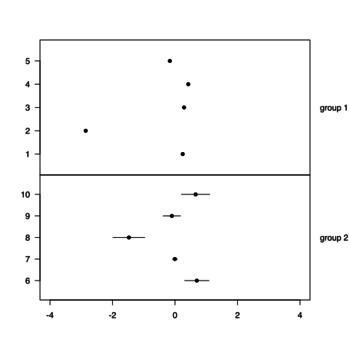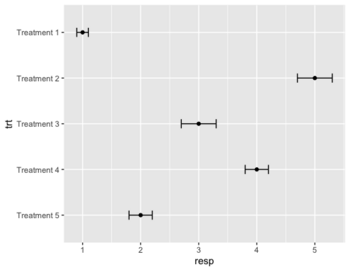Ggplot2: Difference between revisions
| (225 intermediate revisions by the same user not shown) | |||
| Line 57: | Line 57: | ||
* [https://cedricscherer.netlify.app/2019/08/05/a-ggplot2-tutorial-for-beautiful-plotting-in-r/ A ggplot2 Tutorial for Beautiful Plotting in R] | * [https://cedricscherer.netlify.app/2019/08/05/a-ggplot2-tutorial-for-beautiful-plotting-in-r/ A ggplot2 Tutorial for Beautiful Plotting in R] | ||
* [https://rafalab.github.io/dsbook/ggplot2.html Chapter 7 ggplot2] from Introduction to Data Science Data Analysis and Prediction Algorithms with R, Rafael A. Irizarry | * [https://rafalab.github.io/dsbook/ggplot2.html Chapter 7 ggplot2] from Introduction to Data Science Data Analysis and Prediction Algorithms with R, Rafael A. Irizarry | ||
* [https://youtu.be/h29g21z0a68 Plotting anything with ggplot2] - ggplot2 workshop part 1 (youtube) by Thomas Lin Pedersen | |||
== Help == | == Help == | ||
| Line 67: | Line 68: | ||
* https://www.r-graph-gallery.com/ggplot2-package.html | * https://www.r-graph-gallery.com/ggplot2-package.html | ||
* http://r-statistics.co/Top50-Ggplot2-Visualizations-MasterList-R-Code.html | * http://r-statistics.co/Top50-Ggplot2-Visualizations-MasterList-R-Code.html | ||
* [https://www.cedricscherer.com/2019/08/05/a-ggplot2-tutorial-for-beautiful-plotting-in-r/ A ggplot2 Tutorial for Beautiful Plotting in R] | |||
= Some examples = | = Some examples = | ||
| Line 160: | Line 162: | ||
== facet_wrap and facet_grid to create a panel of plots == | == facet_wrap and facet_grid to create a panel of plots == | ||
* '''facet_wrap'''(, nrow=4, ncol=3) in ggplot2 provides a solution similar to par(mfrow=c(4, 3)) in base R. | |||
* http://www.cookbook-r.com/Graphs/Facets_(ggplot2)/ | * http://www.cookbook-r.com/Graphs/Facets_(ggplot2)/ | ||
* Another example [http://freerangestats.info/blog/2019/05/19/polls-v-results Polls v results] | * Another example [http://freerangestats.info/blog/2019/05/19/polls-v-results Polls v results] | ||
| Line 177: | Line 180: | ||
[https://juliasilge.com/blog/nber-papers/ Multiclass predictive modeling for #TidyTuesday NBER papers] | [https://juliasilge.com/blog/nber-papers/ Multiclass predictive modeling for #TidyTuesday NBER papers] | ||
</li> | </li> | ||
<li>[https://stackoverflow.com/a/63858007 changing the facet_wrap labels using labeller in ggplot2]. The solution is to create a '''labeller''' function as a function of a variable x (or any other name as long as it's not the faceting variables' names) and then coerce to labeller with '''as_labeller'''. | |||
</ul> | </ul> | ||
== lattice::xyplot == | |||
<pre> | |||
df <- data.frame(x = rnorm(100), y = rnorm(100), group = sample(c("A", "B"), 100, replace = TRUE)) | |||
# Use the xyplot() function to create the plot | |||
# with each group represented by a different color | |||
# result is 1 plot only | |||
# no annotation | |||
xyplot(y ~ x, data = df, groups = group) | |||
</pre> | |||
<pre> | |||
df <- data.frame(x = rnorm(100), y = rnorm(100), | |||
group = sample(c("A", "B"), 100, replace = TRUE), | |||
time = sample(c("T1", "T2"), 100, replace = TRUE)) | |||
# 2 plots grouped by time | |||
# two colors (defined by group) was used in each plot | |||
# no annotation | |||
xyplot(y ~ x | time, groups = group, data = df) | |||
</pre> | |||
For more complicated plot, we can use the '''panel''' parameter. | |||
= Color palette = | = Color palette = | ||
| Line 185: | Line 212: | ||
* [https://rpkgs.datanovia.com/ggpubr/index.html ggpubr] package which was used by [https://cran.r-project.org/web/packages/survminer/index.html survminer]. The colors c("#00AFBB", "#FC4E07") are very similar to the colors used in [https://rpkgs.datanovia.com/survminer/index.html ggsurvplot()]. Colorblind-friendly palette | * [https://rpkgs.datanovia.com/ggpubr/index.html ggpubr] package which was used by [https://cran.r-project.org/web/packages/survminer/index.html survminer]. The colors c("#00AFBB", "#FC4E07") are very similar to the colors used in [https://rpkgs.datanovia.com/survminer/index.html ggsurvplot()]. Colorblind-friendly palette | ||
* [https://journals.plos.org/ploscompbiol/article?id=10.1371/journal.pcbi.1008259 Ten simple rules to colorize biological data visualization] | * [https://journals.plos.org/ploscompbiol/article?id=10.1371/journal.pcbi.1008259 Ten simple rules to colorize biological data visualization] | ||
* [https://twitter.com/moriah_taylor58/status/1395431000977649665?s=20 a MEGA thread about all the ways you can choose a palette] May 2021 | |||
== Top color palettes == | |||
* [https://www.datanovia.com/en/blog/top-r-color-palettes-to-know-for-great-data-visualization/ Top R Color Palettes to Know for Great Data Visualization] | |||
== Display color palettes == | |||
<ul> | |||
<li>Use barplot() | |||
<pre> | |||
pal <- c("#E41A1C", "#377EB8", "#4DAF4A", "#984EA3", "#FF7F00") | |||
# pal <- sample(colors(), 10) # randomly pick 10 colors | |||
barplot(rep(1, length(pal)), col = pal, space = 0, | |||
axes = FALSE, border = NA) | |||
par()$usr | |||
# [1] -0.20 5.20 -0.01 1.00 | |||
</pre> | |||
[[File:Palettebarplot.png|250px]] | |||
<li>Use heatmap() | |||
<pre> | |||
pal <- c("#E41A1C", "#377EB8", "#4DAF4A", "#984EA3", "#FF7F00") | |||
pal <- matrix(pal, nr=2) # acknowledge a nice warning message | |||
# [,1] [,2] [,3] | |||
# [1,] "#E41A1C" "#4DAF4A" "#FF7F00" | |||
# [2,] "#377EB8" "#984EA3" "#E41A1C" | |||
pal_matrix <- matrix(seq_along(pal), nr=nrow(pal), nc=ncol(pal)) | |||
heatmap(pal_matrix, col = pal, Rowv = NA, Colv = NA, scale = "none", | |||
ylab = "", xlab = "", main = "", margins = c(5, 5)) | |||
# 2 rows, 3 columns with labeling on two axes | |||
par()$usr | |||
# [1] 0 1 0 1 | |||
</pre> | |||
[[File:Paletteheatmap.png|250px]] | |||
<li>Use image() | |||
<pre> | |||
pal <- palette() # R 4.0 has a new default palette | |||
# The old colors are highly saturated and vary enormousely | |||
# in terms of luminance | |||
# [1] "black" "#DF536B" "#61D04F" "#2297E6" "#28E2E5" "#CD0BBC" "#F5C710" | |||
# [8] "gray62" | |||
pal_matrix <- matrix(seq_along(pal), nr=1) | |||
image(pal_matrix, col = pal, axes = FALSE) | |||
# 8 rows, 1 column, but no labeling | |||
# Starting from bottom, left. | |||
par()$usr # change with the data dim | |||
text(0, (par()$usr[4]-par()$usr[3])/8*c(0:7), | |||
labels = pal) | |||
</pre> | |||
[[File:Rpalette.png|250px]] | |||
<li>Use [https://scales.r-lib.org/reference/show_col.html scales::show_col()] | |||
<pre> | |||
scales::show_col(palette()) | |||
</pre> | |||
[[File:Paletteshowcol.png|250px]] | |||
</ul> | |||
== colors() == | |||
In R, colors() is a function that returns a character vector of color names available in R. | |||
To obtain the hexadecimal codes for all colors obtained by colors() | |||
<pre> | |||
rgb_values <- col2rgb(colors()) | |||
# Convert the RGB values to hexadecimal codes | |||
hex_codes <- apply(rgb_values, 2, | |||
function(x) rgb(x[1], x[2], x[3], | |||
maxColorValue = 255)) | |||
# View the first few hexadecimal codes | |||
head(hex_codes) | |||
</pre> | |||
== palette() == | |||
* [https://developer.r-project.org/Blog/public/2019/11/21/a-new-palette-for-r/ A New palette() for R 4.0] | |||
* [https://rdrr.io/r/grDevices/palette.html ?palette] and [https://stat.ethz.ch/R-manual/R-devel/library/grDevices/html/palette.html the dev version] | |||
* [https://detroitdatalab.com/2020/04/28/4-for-4-0-0-four-useful-new-features-in-r-4-0-0/ 4 for 4.0.0 – Four Useful New Features in R 4.0.0] | |||
* [https://flowingdata.com/2023/05/10/improved-color-palettes-in-r/ Improved color palettes in R] | |||
== rainbow == | |||
* [https://www.rdocumentation.org/packages/grDevices/versions/3.6.2/topics/Palettes ?rainbow] | |||
* Below compare the effects of 's' and 'v' parameters. '''s (saturation)''' and '''v (value)''': These parameters control the color intensity and brightness, respectively. See also [https://en.wikipedia.org/wiki/HSL_and_HSV HSL and HSV] from wikipedia. | |||
** '''Saturation (s)''': Determines how '''vivid''' or muted the colors are. A value of 1 (default) means fully saturated colors, while lower values reduce the intensity. | |||
** '''Value (v)''': Controls the '''brightness'''. A value of 1 (default) results in full brightness, while lower values make the colors darker. | |||
[[File:Rainbow default.png|250px]] [[File:Rainbow s05.png|250px]] [[File:Rainbow v05.png|250px]] | |||
== Color blind == | |||
[https://cran.r-project.org/web/packages/colorblindcheck/index.html colorblindcheck]: Check Color Palettes for Problems with Color Vision Deficiency | |||
== Color picker == | == Color picker == | ||
| Line 196: | Line 315: | ||
</pre> | </pre> | ||
== Color names == | == Color names, Complementary/Inverted colors == | ||
[https://www.colorhexa.com/color-names ColorHexa] | * [https://github.com/msanchez-beeckman/colornamer ColorNameR] - A tool for transforming coordinates in a color space to common color names using data from the Royal Horticultural Society and the International Union for the Protection of New Varieties of Plants. | ||
* [https://www.colorhexa.com/color-names ColorHexa] | |||
* https://pinetools.com/invert-color | |||
== colorspace package == | == colorspace package == | ||
[https://cran.r-project.org/web/packages/colorspace/index.html colorspace]: A Toolbox for Manipulating and Assessing Colors and Palettes | * https://colorspace.r-forge.r-project.org/ More vignettes than CRAN have. | ||
** [http://colorspace.r-forge.r-project.org/articles/approximations.html Approximating Palettes from Other Packages] | |||
** it supports R's base graphics and also ggplot2 (eg [http://colorspace.r-forge.r-project.org/reference/scale_colour_discrete_qualitative.html scale_fill_discrete_qualitative(palette)] , notice the part '''discrete_quantitative''' is specific to colorspace package). See my [[Ggplot2#Color_fill.2Fscale_fill_XXX|ggplot2]] page. | |||
* CRAN [https://cran.r-project.org/web/packages/colorspace/index.html colorspace]: A Toolbox for Manipulating and Assessing Colors and Palettes | |||
* Some [https://www.brodrigues.co/blog/2020-04-12-basic_ggplot2/ examples]. The palette selections are different from scale_fill_XXX(). Note that the number of classes can be arbitrary in scale_fill_discrete_qualitative(). | |||
* Note | |||
** why it does not "Set 1"? | |||
** the "Dark 2" colors are not the same as in [https://www.datanovia.com/en/blog/the-a-z-of-rcolorbrewer-palette/ RColorBrewer]. | |||
== cols4all == | |||
* https://github.com/mtennekes/cols4all. You can use '''cols4all''' palettes in ggplot2. | |||
<syntaxhighlight lang='rsplus'> | |||
c4a_gui() # it will create a shiny interface (but R will not be used at the same time) | |||
c4a_types() # understand abbreviation | |||
c4a_series() # 16 series like brewer, hcl, tableau, viridis, etc | |||
c4a_overview() # how many palettes per series x types | |||
c4a_palettes(type = "div", series = "hcl") # What palettes are available | |||
# Give me the colors | |||
c4a("hcl.purple_green", 11) | |||
c4a("brewer.accent", 2) # the 1st one on the website | |||
# Plot the colors | |||
c4a_plot("hcl.purple_green", 11, include.na = TRUE) | |||
</syntaxhighlight> | |||
== *paletteer package == | == *paletteer package == | ||
* [https://paulvanderlaken.com/2020/03/17/paletteer-hundreds-of-color-palettes-in-r/ The paletteer package offers direct access to 1759 color palettes, from 50 different packages!] | * [https://paulvanderlaken.com/2020/03/17/paletteer-hundreds-of-color-palettes-in-r/ The paletteer package offers direct access to 1759 color palettes, from 50 different packages!] | ||
* [https://emilhvitfeldt.github.io/paletteer/index.html paletteer], [https://emilhvitfeldt.github.io/paletteer/reference/paletteer_d.html paletteer_d()] function for getting discrete palette by package and name. | * [https://emilhvitfeldt.github.io/paletteer/index.html paletteer], [https://emilhvitfeldt.github.io/paletteer/reference/paletteer_d.html paletteer_d()] function for getting discrete palette by package and name. | ||
* Interactive https://emilhvitfeldt.github.io/r-color-palettes/discrete.html and choose 'sort by length' | |||
* [https://github.com/EmilHvitfeldt/r-color-palettes/blob/master/type-sorted-palettes.md#diverging-color-palettes Palettes sorted by type (Sequential/Diverging/Qualitative)] | |||
* [https://awesomeopensource.com/project/EmilHvitfeldt/r-color-palettes *More examples with a gallery] | * [https://awesomeopensource.com/project/EmilHvitfeldt/r-color-palettes *More examples with a gallery] | ||
< | <syntaxhighlight lang='rsplus'> | ||
paletteer_d("RColorBrewer::RdBu") | paletteer_d("RColorBrewer::RdBu") | ||
#67001FFF #B2182BFF #D6604DFF #F4A582FF #FDDBC7FF #F7F7F7FF | #67001FFF #B2182BFF #D6604DFF #F4A582FF #FDDBC7FF #F7F7F7FF | ||
| Line 226: | Line 375: | ||
"versicolor" = "#5C88DAFF", | "versicolor" = "#5C88DAFF", | ||
"virginica" = "#84BD00FF")) | "virginica" = "#84BD00FF")) | ||
</syntaxhighlight> | |||
== ggsci == | |||
* https://cran.r-project.org/web/packages/ggsci/index.html | |||
* https://nanx.me/ggsci/ | |||
== ggokabeito == | |||
[https://cran.r-project.org/web/packages/ggokabeito/index.html ggokabeito]: Colorblind-friendly, qualitative 'Okabe-Ito' Scales for ggplot2 and ggraph. It seems to only support up to 9 classes/colors. It will give an error message if we have too many classes; e.g. Error: Insufficient values in manual scale. 15 needed but only 9 provided.) | |||
<pre> | |||
# Bad | |||
ggplot(mpg, aes(hwy, color = class, fill = class)) + | |||
geom_density(alpha = .8) | |||
# Bad (single color) | |||
ggplot(mpg, aes(hwy, color = class, fill = class)) + | |||
geom_density(alpha = .8) + | |||
scale_fill_brewer(name = "Class") + | |||
scale_color_brewer(name = "Class") | |||
# Bad | |||
ggplot(mpg, aes(hwy, color = class, fill = class)) + | |||
geom_density(alpha = .8) + | |||
scale_fill_brewer(name = "Class", palette ="Set1") + | |||
scale_color_brewer(name = "Class", palette ="Set1") | |||
# Nice | |||
ggplot(mpg, aes(hwy, color = class, fill = class)) + | |||
geom_density(alpha = .8) + | |||
scale_fill_okabe_ito(name = "Class") + | |||
scale_color_okabe_ito(name = "Class") | |||
</pre> | </pre> | ||
== Pride palette == | |||
[https://turtletopia.github.io/2022/08/12/show-pride-on-your-plots/ Show Pride on Your Plots]. [https://github.com/turtletopia/gglgbtq gglgbtq] package | |||
== unikn == | |||
* [https://github.com/hneth/unikn unikn]: Enabling corporate design elements in R (with colors and color-related functions). The curve plot is interesting. | |||
* [https://www.infoworld.com/article/3667496/12-ggplot-extensions-for-snazzier-r-graphics.html?page=2 12 ggplot extensions for snazzier R graphics] | |||
== Colour related aesthetics: colour, fill and alpha == | == Colour related aesthetics: colour, fill and alpha == | ||
| Line 236: | Line 422: | ||
ggplot(aes(x, y)) + | ggplot(aes(x, y)) + | ||
geom_point(alpha=.1) | geom_point(alpha=.1) | ||
</pre> | |||
For base R, we can use the '''alpha''' parameter [https://www.rdocumentation.org/packages/grDevices/versions/3.6.2/topics/rgb rgb(,,,alpha)], | |||
<pre> | |||
plot(x, y, col=rgb(0,0,0, alpha=.1)) | |||
polygon(df, col=adjustcolor(c("red", "blue"), alpha.f=.3)) | |||
</pre> | </pre> | ||
| Line 250: | Line 441: | ||
ggplot(mtcars, aes(x=hp, y=mpg)) + | ggplot(mtcars, aes(x=hp, y=mpg)) + | ||
geom_point(aes(shape=factor(cyl), colour=factor(cyl))) + | geom_point(aes(shape=factor(cyl), colour=factor(cyl))) + | ||
scale_shape_discrete("Cylinders") + | scale_shape_discrete("Cylinders") + # change the legend title from 'factor(cyl)' to 'Cylinders' | ||
scale_colour_discrete("Cylinders") | scale_colour_discrete("Cylinders") # combine shape and colour in one legend; avoid another legend for colour | ||
</pre> | </pre> | ||
</li> | </li> | ||
<li>[https://www.datanovia.com/en/blog/ggplot-point-shapes-best-tips/ GGPLOT Point Shapes Best Tips] </li> | |||
<li>Simulated data | |||
<pre> | |||
df <- data.frame(x = rnorm(100), y = rnorm(100), | |||
Treatment = rep(c("Before", "After"), each = 50), | |||
Response = rep(c("Sensitive", "Resistant"), each = 50), | |||
Subject = rep(1:50, times = 2)) | |||
ggplot(df, aes(x = x, y = y, shape = Treatment, color = Response)) + | |||
geom_point() + | |||
geom_line(aes(group = Subject), alpha = 0.5) + # Add lines connecting the same subject | |||
scale_shape_manual(values = c(16, 17)) + # You can choose different shapes | |||
scale_color_manual(values = c("blue", "red")) + # You can choose different colors | |||
theme_minimal() + | |||
labs(title = "Scatterplot with Different Shapes and Colors", | |||
x = "X-axis label", | |||
y = "Y-axis label", | |||
shape = "Treatment", | |||
color = "Response") | |||
</pre> | |||
</ul> | </ul> | ||
| Line 259: | Line 470: | ||
* Scales control the mapping from data to aesthetics. They take your data and turn it into something that you can see, like '''size, colour, position''' or '''shape'''. | * Scales control the mapping from data to aesthetics. They take your data and turn it into something that you can see, like '''size, colour, position''' or '''shape'''. | ||
* Scales also provide the tools that let you read the plot: the axes and legends. | * Scales also provide the tools that let you read the plot: the axes and legends. | ||
* [https://www.tidyverse.org/blog/2022/04/scales-1-2-0/ scales 1.2.0] | |||
=== ggplot2:: | === ggplot2::scale_* - axes/axis, legend === | ||
https://ggplot2-book.org/scales.html | https://ggplot2-book.org/scales.html and [https://ggplot2.tidyverse.org/reference/index.html#scales reference of all scale_* functions]. Modifies the scales of the axes, such as the x- and y-axes, color, size, etc. | ||
Naming convention: <span style="color: red">'''scale_AestheticName_NameDataType'''</span> where | Naming convention: <span style="color: red">'''scale_AestheticName_NameDataType'''</span> where | ||
* AestheticName can be '''x, y, color, fill, size, shape, ...''' | * AestheticName can be '''x, y, color, fill, size, shape, ...''' | ||
* NameDataType can be '''continuous, discrete''', '''manual''' or '''gradient'''. | * NameDataType can be '''continuous, discrete''', '''manual''' or '''gradient'''. | ||
* Table of common functions | |||
{| class="wikitable" | |||
|- | |||
! | |||
! scale_AestheticName_NameDataType | |||
|- | |||
| | |||
| scale_x_continuous<br />scale_x_discrete | |||
|- | |||
| | |||
| scale_x_log10 | |||
|- | |||
| | |||
| scale_color_continuous, <br />scale_color_gradient<br />scale_color_discrete<br />scale_color_brewer<br />scale_color_manual<br />scale_color_paletteer_d | |||
|- | |||
| | |||
| scale_shape_discrete | |||
|- | |||
| | |||
| scale_fill_brewer, <br />scale_fill_continuous,<br />scale_fill_discrete, <br />scale_fill_gradient<br />scale_fill_grey, <br />scale_fill_hue<br />scale_fill_manual,<br />scale_colour_viridis_d | |||
|} | |||
Examples: | Examples: | ||
| Line 318: | Line 552: | ||
Browse[2]> coordinates$chr | Browse[2]> coordinates$chr | ||
[1] "20" "8" "16" "16" | [1] "20" "8" "16" "16" | ||
</pre> | |||
</li> | |||
<li>Differences of scale_color_gradient() and scale_color_continuous() | |||
* '''scale_color_gradient()''' (more common than scale_color_continuous) is used to map a continuous variable to a color gradient. It takes two arguments: low and high, which specify the colors for the minimum and maximum values of the variable, respectively. The gradient is automatically generated between these two colors. | |||
<pre> | |||
ggplot(data = diamonds, aes(x = carat, y = price, color = depth)) + | |||
geom_point() + | |||
scale_color_gradient(low = "blue", high = "red") | |||
</pre> | |||
* '''scale_color_continuous()''' (useful if we want to specify the labels to display on legend) does not automatically generate the color scale. Instead, it requires the user to specify the values to which the colors should be mapped. The limits argument sets the minimum and maximum values for the variable, and the breaks argument specifies the values at which breaks occur. | |||
<pre> | |||
ggplot(data = diamonds, aes(x = carat, y = price, color = depth)) + | |||
geom_point() + | |||
scale_color_continuous(name = "Depth", | |||
limits = c(40, 80), | |||
breaks = c(40, 60, 80), | |||
labels = c("Shallow", "Moderate", "Deep"), # display on legend | |||
type = "gradient") | |||
</pre> | </pre> | ||
</li> | </li> | ||
| Line 331: | Line 583: | ||
=== Emulate ggplot2 default color palette === | === Emulate ggplot2 default color palette === | ||
It is just equally spaced hues around the color wheel. | [[File:Paletteggplot2.png|250px]] | ||
The above can be created by R >= 4.0.0 using the command '''scales::show_col(palette.colors(palette = "ggplot2"))'''. We should ignore the 1st color (black). Also if n>=5, the colors do not match with the result of '''show_col(hue_pal()(5))''' . | |||
'''Answer 1''' It is just equally spaced hues around the color wheel. | |||
[https://stackoverflow.com/questions/8197559/emulate-ggplot2-default-color-palette Emulate ggplot2 default color palette] | [https://stackoverflow.com/questions/8197559/emulate-ggplot2-default-color-palette Emulate ggplot2 default color palette] | ||
<syntaxhighlight lang='rsplus'> | <syntaxhighlight lang='rsplus'> | ||
gg_color_hue <- function(n) { | gg_color_hue <- function(n) { | ||
| Line 355: | Line 609: | ||
show_col(hue_pal()(4)) # ("#F8766D", "#7CAE00", "#00BFC4", "#C77CFF") | show_col(hue_pal()(4)) # ("#F8766D", "#7CAE00", "#00BFC4", "#C77CFF") | ||
# (Salmon, Christi, Iris Blue, Heliotrope) | # (Salmon, Christi, Iris Blue, Heliotrope) | ||
show_col(hue_pal()(3)) # ("#F8766D", "#00BA38", "#619CFF") | |||
# (Salmon, Dark Pastel Green, Cornflower Blue) | |||
show_col(hue_pal()(2)) # ("#F8767D", "#00BFC4") = (salmon, iris blue) | show_col(hue_pal()(2)) # ("#F8767D", "#00BFC4") = (salmon, iris blue) | ||
# see https://www.htmlcsscolor.com/ for color names | # see https://www.htmlcsscolor.com/ for color names | ||
| Line 360: | Line 616: | ||
See also the last example in [https://ggobi.github.io/ggally/reference/ggsurv.html ggsurv()] where the KM plots have 4 strata. The colors can be obtained by '''scales::hue_pal()(4)''' with hue_pal()'s default arguments. | See also the last example in [https://ggobi.github.io/ggally/reference/ggsurv.html ggsurv()] where the KM plots have 4 strata. The colors can be obtained by '''scales::hue_pal()(4)''' with hue_pal()'s default arguments. | ||
R has a function called colorName() to convert a hex code to color name; see [https://www.stat.auckland.ac.nz/~paul/Reports/roloc/intro/roloc.html roloc] package. | R has a function called colorName() to convert a hex code to color name; see [https://www.stat.auckland.ac.nz/~paul/Reports/roloc/intro/roloc.html roloc] package on [https://cran.case.edu/web/packages/roloc/index.html CRAN]. | ||
=== transform scales === | === transform scales === | ||
| Line 366: | Line 622: | ||
== Class variables == | == Class variables == | ||
"Set1" is a good choice. See [http://www.sthda.com/english/wiki/colors-in-r RColorBrewer::display.brewer.all()] | <ul> | ||
<li>"Set1" is a good choice. See [http://www.sthda.com/english/wiki/colors-in-r RColorBrewer::display.brewer.all()] | |||
<li>For ordinal variable, brewer.pal(n, "Spectral") is good. But the middle color is too light. So I modify the middle color | |||
<pre> | |||
brewer.pal(5, "Spectral") | |||
cols[3] <- "#D4C683" # middle of "#FDAE61" and "#ABDDA4" | |||
</pre> | |||
</ul> | |||
== Red, Green, Blue alternatives == | |||
* Red: "maroon" | |||
== Heatmap for single channel == | == Heatmap for single channel == | ||
| Line 392: | Line 658: | ||
[[File:Twopalette.svg|300px]] | [[File:Twopalette.svg|300px]] | ||
== Don't rely on color to explain the data == | |||
[https://cran.r-project.org/web/packages/ggpattern/index.html ggpattern] | |||
== Don't use very bright or low-contrast colors, accessibility == | |||
* [https://color.a11y.com/ Color Contrast Accessibility Validator] | |||
* [https://developers.google.com/web/tools/lighthouse/ Google Lighthouse] | |||
== Create your own scale_fill_FOO and scale_color_FOO == | |||
[https://www.jumpingrivers.com/blog/custom-colour-palettes-for-ggplot2/ Custom colour palettes for {ggplot2}] | |||
= Themes and background for ggplot2 = | = Themes and background for ggplot2 = | ||
* [https://www.r-bloggers.com/2023/11/getting-started-with-theme/ Getting started with theme()] 2023/11/23 | |||
* [https://henrywang.nl/ggplot2-theme-elements-demonstration/ ggplot2 Theme Elements Demonstration] | * [https://henrywang.nl/ggplot2-theme-elements-demonstration/ ggplot2 Theme Elements Demonstration] | ||
| Line 446: | Line 723: | ||
ggplot() + geom_bar() + | ggplot() + geom_bar() + | ||
theme_bw() | theme_bw() # very similar to theme_light() | ||
# have grid lines | |||
ggplot() + geom_bar() + | |||
theme_classic() # similar to base R graphic | |||
# no borders on top and right | |||
ggplot() + geom_bar() + | ggplot() + geom_bar() + | ||
theme_minimal() | theme_minimal() # no edge | ||
ggplot() + geom_bar() + | ggplot() + geom_bar() + | ||
theme_void() | theme_void() # no grid, no edge | ||
ggplot() + geom_bar() + | ggplot() + geom_bar() + | ||
| Line 463: | Line 744: | ||
[http://www.shanelynn.ie/themes-and-colours-for-r-ggplots-with-ggthemr/ ggthmr] package | [http://www.shanelynn.ie/themes-and-colours-for-r-ggplots-with-ggthemr/ ggthmr] package | ||
== | == Font size == | ||
* https:// | * https://ggplot2.tidyverse.org/reference/theme.html | ||
* https:// | * [https://statisticsglobe.com/change-font-size-of-ggplot2-plot-in-r-axis-text-main-title-legend Change Font Size of ggplot2 Plot in R (5 Examples) | Axis Text, Main Title & Legend] | ||
* [ | * [https://stackoverflow.com/a/34610941 What is the default font for ggplot2] | ||
* [http://www.cookbook-r.com/Graphs/Fonts/ Fonts] from Cookbook for R | |||
For example to make the subtitle font size smaller | |||
<pre> | |||
my_ggp + theme(plot.sybtitle = element_text(size = 8)) | |||
# Default font size seems to be 11 for title/subtitle | |||
</pre> | |||
== | == Remove x and y axis titles == | ||
[ | [http://www.sthda.com/english/wiki/ggplot2-title-main-axis-and-legend-titles#remove-x-and-y-axis-labels ggplot2 title : main, axis and legend titles] | ||
== Rotate x-axis labels == | == Rotate x-axis labels, change colors == | ||
Counter-clockwise | |||
<pre> | <pre> | ||
theme(axis.text.x = element_text(angle = 90) | theme(axis.text.x = element_text(angle = 90, size=5, hjust=1) | ||
</pre> | </pre> | ||
[https://stackoverflow.com/a/38862452 customize ggplot2 axis labels with different colors] | |||
== Add axis on top or right hand side == | == Add axis on top or right hand side == | ||
| Line 541: | Line 832: | ||
* [http://www.sthda.com/english/wiki/scatter-plot-matrices-r-base-graphs Scatter Plot Matrices] | * [http://www.sthda.com/english/wiki/scatter-plot-matrices-r-base-graphs Scatter Plot Matrices] | ||
* [https://www.r-bloggers.com/2011/06/example-8-41-scatterplot-with-marginal-histograms/ Example 8.41: Scatterplot with marginal histograms] (old fashion, based on ''layout()'') | * [https://www.r-bloggers.com/2011/06/example-8-41-scatterplot-with-marginal-histograms/ Example 8.41: Scatterplot with marginal histograms] (old fashion, based on ''layout()'') | ||
=== aes(color) === | |||
<ul> | |||
<li><span style="color: blue">Discrete colors</span>. [https://tidyverse.github.io/ggplot2-docs/reference/scale_brewer.html ?scale_colour_brewer]. [https://stackoverflow.com/a/67375729 How to fix 'continuous value supplied to discrete scale' in with scale_color_brewer]. [https://statisticsglobe.com/scale-colour-fill-brewer-rcolorbrewer-package-r Change ggplot2 Color & Fill Using scale_brewer Functions & RColorBrewer Package in R] | |||
<pre> | |||
ggplot(mpg, aes(x = hwy, y = cty)) + | |||
geom_point(aes(color = class), palette = "Set2") | |||
ggplot(mpg, aes(x = displ, y = hwy, colour = manufacturer)) + | |||
geom_point() + | |||
scale_colour_brewer(palette = "Set3") | |||
</pre> | |||
<li><span style="color: blue">Continuous colors</span>. The default color scale is [https://tidyverse.github.io/ggplot2-docs/reference/scale_gradient.html ?scale_colour_gradient] with prespecified 'low' and 'high' colors. [https://ggplot2.tidyverse.org/reference/scale_colour_continuous.html ?scale_colour_continuous]. | |||
<pre> | |||
ggplot(mpg, aes(x = displ, y = hwy, color = cty)) + | |||
geom_point(size = 2) + | |||
scale_color_continuous("City Miles Per Gallon") | |||
# scale_color_continuous("City MPG Rating", low = "springgreen3", high = "red") | |||
</pre> | |||
<li>[http://www.sthda.com/english/wiki/ggplot2-colors-how-to-change-colors-automatically-and-manually ggplot2 colors : How to change colors automatically and manually?] (mainly the scatterplot and box plots) | |||
<li>[https://ggplot2.tidyverse.org/reference/aes_colour_fill_alpha.html Colour related aesthetics: colour, fill, and alpha] | |||
</li> | |||
<li>[https://stackoverflow.com/a/43770608 how to change the color in geom_point or lines in ggplot]. | |||
* color is used outside '''aes()''': the ''color'' parameter can be used to specify the color name (eg 'red') | |||
* color is used inside '''aes()''': it is used to specify the category/level of colors. It does not work as expected if we try to specify colors explicitly; e.g. ''aes(color=c("red", "red", "green"))''. In this case, the color names becomes a factor. | |||
<pre> | |||
ggplot() + | |||
geom_point(data = data, aes(x = time, y = y, color = sample),size=4) + | |||
scale_color_manual(values = c("A" = "black", "B" = "red")) | |||
</pre> | |||
</li> | |||
<li>[https://www.sharpsightlabs.com/blog/highlight-data-in-ggplot2/ How to highlight data in ggplot2] </li> | |||
</ul> | |||
=== groups === | |||
* [https://datavizpyr.com/add-regression-line-per-group-to-scatterplot-in-r/ How To Add Regression Line per Group to Scatterplot in ggplot2?] '''geom_smooth()''' | |||
* Multiple fitted lines in one plot | |||
[[File:Geom smooth ex.png|250px]] | |||
=== Bubble Chart === | === Bubble Chart === | ||
[https://finnstats.com/index.php/2021/06/18/how-to-create-a-bubble-chart-in-r/ Bubble Chart in R-ggplot & Plotly] | * [https://www.data-to-viz.com/graph/bubble.html BUBBLE PLOT] | ||
* [https://finnstats.com/index.php/2021/06/18/how-to-create-a-bubble-chart-in-r/ Bubble Chart in R-ggplot & Plotly] | |||
=== Ellipse === | === Ellipse === | ||
* [https://ggplot2.tidyverse.org/reference/stat_ellipse.html ggplot2::stat_ellipse()] | * [https://ggplot2.tidyverse.org/reference/stat_ellipse.html ggplot2::stat_ellipse()] | ||
* [https://stackoverflow.com/a/5262141 How can a data ellipse be superimposed on a ggplot2 scatterplot?]. Hint: use the [https://cran.r-project.org/web/packages/ellipse/index.html ellipse] package. | * [https://stackoverflow.com/a/5262141 How can a data ellipse be superimposed on a ggplot2 scatterplot?]. Hint: use the [https://cran.r-project.org/web/packages/ellipse/index.html ellipse] package. | ||
=== ggside: scatterplot + marginal density plot === | |||
* https://cran.r-project.org/web/packages/ggside/index.html | |||
* [https://www.business-science.io/code-tools/2021/05/18/marginal_distributions.html ggside] package | |||
=== ggextra: scatterplot + marginal histogram/density === | |||
https://github.com/daattali/ggExtra | |||
== Line plots == | == Line plots == | ||
| Line 556: | Line 893: | ||
* [https://www.r-bloggers.com/2020/12/how-to-make-stunning-line-charts-in-r-a-complete-guide-with-ggplot2/ How to Make Stunning Line Charts in R: A Complete Guide with ggplot2] | * [https://www.r-bloggers.com/2020/12/how-to-make-stunning-line-charts-in-r-a-complete-guide-with-ggplot2/ How to Make Stunning Line Charts in R: A Complete Guide with ggplot2] | ||
=== Ridgeline plots === | === Ridgeline plots, mountain diagram === | ||
* [https://github.com/wilkelab/ggridges?s=09 ggridges]: Ridgeline plots in ggplot2 | * [https://github.com/wilkelab/ggridges?s=09 ggridges]: Ridgeline plots in ggplot2 | ||
* [https://www.datanovia.com/en/blog/elegant-visualization-of-density-distribution-in-r-using-ridgeline Elegant Visualization of Density Distribution in R Using Ridgeline] | * [https://www.datanovia.com/en/blog/elegant-visualization-of-density-distribution-in-r-using-ridgeline Elegant Visualization of Density Distribution in R Using Ridgeline] | ||
* [https://www.nature.com/articles/s41598-021-03432-3/figures/1 An example] from ''Scientific Reports''. | |||
== Histogram == | == Histogram == | ||
| Line 614: | Line 952: | ||
[https://ggplot2.tidyverse.org/reference/index.html Reference from ggplot2]. scale_fill_binned, '''scale_fill_brewer''', scale_fill_continuous, scale_fill_date, scale_fill_datetime, scale_fill_discrete, scale_fill_distiller, scale_fill_gradient, scale_fill_gradientc, scale_fill_gradientn, scale_fill_grey, '''scale_fill_hue''', scale_fill_identity, '''scale_fill_manual''', scale_fill_ordinal, scale_fill_steps, scale_fill_steps2, scale_fill_stepsn, scale_fill_viridis_b, scale_fill_viridis_c, scale_fill_viridis_d | [https://ggplot2.tidyverse.org/reference/index.html Reference from ggplot2]. scale_fill_binned, '''scale_fill_brewer''', scale_fill_continuous, scale_fill_date, scale_fill_datetime, scale_fill_discrete, scale_fill_distiller, scale_fill_gradient, scale_fill_gradientc, scale_fill_gradientn, scale_fill_grey, '''scale_fill_hue''', scale_fill_identity, '''scale_fill_manual''', scale_fill_ordinal, scale_fill_steps, scale_fill_steps2, scale_fill_stepsn, scale_fill_viridis_b, scale_fill_viridis_c, scale_fill_viridis_d | ||
=== Jittering === | === Jittering - plot the data on top of the boxplot === | ||
[[Statistics#Box.28Box_and_whisker.29_plot_in_R|What is a boxplot]] | <ul> | ||
<li>[[Statistics#Box.28Box_and_whisker.29_plot_in_R|What is a boxplot]] </li> | |||
<li>Quick look | |||
<syntaxhighlight lang='rsplus'> | <syntaxhighlight lang='rsplus'> | ||
# Only 1 variable | # Only 1 variable | ||
| Line 628: | Line 967: | ||
ggplot() + geom_boxplot(mapping = aes(x, y)) | ggplot() + geom_boxplot(mapping = aes(x, y)) | ||
</syntaxhighlight> | </syntaxhighlight> | ||
</li> | |||
<li>[https://ggplot2.tidyverse.org/reference/geom_jitter.html geom_jitter()]</li> | |||
<li>geom_jitter can affect both X and Y values. | |||
<pre> | |||
tibble(x=1:4, y=1:4) %>% ggplot(aes(x, y)) + geom_jitter() | |||
</pre> | |||
</li> | |||
<li>https://stackoverflow.com/a/17560113 </li> | |||
<li>[https://stackoverflow.com/a/48822620 How to make scatterplot with geom_jitter plot reproducible?] | |||
<pre> | |||
set.seed(1); data %>% | |||
ggplot() + | |||
geom_jitter(aes(T.categ, sex, colour = status)) | |||
</pre> | |||
</li> | |||
<li>[https://r-charts.com/distribution/box-plot-jitter-ggplot2/ Boxplot with jittered data points in ggplot2] </li> | |||
<syntaxhighlight lang='rsplus'> | <syntaxhighlight lang='rsplus'> | ||
# df2 is n x 2 | # df2 is n x 2 | ||
| Line 640: | Line 990: | ||
labs(title="", y = "", x = "nboot") | labs(title="", y = "", x = "nboot") | ||
</syntaxhighlight> | </syntaxhighlight> | ||
If we omit the <span style="color: red">outlier.shape=NA</span> option in '''geom_boxplot()''', we will get the following plot where some outliers will appear twice. (Another option is '''outlier.color = NA'''; see [https://stackoverflow.com/a/63785060 extra point at boxplot with jittered points (ggplot2)]). | |||
If we omit the | |||
[[File:Jitterboxplot.png|300px]] | [[File:Jitterboxplot.png|300px]] | ||
</li> | |||
<li>Base plot approach | |||
[http://jtleek.com/genstats/inst/doc/02_13_batch-effects.html Batch effects and confounders] | |||
</li> | |||
<li>Another base plot approach. boxplot() + stripchart(). See [https://r-coder.com/stripchart-r/ Stripchart in R], [https://www.statology.org/strip-chart-r/ How to Create a Strip Chart in R]. Consider to add '''outline = FALSE''' to boxplot() to avoid drawing outliers in boxplot() when stripchart() has been added. | |||
<syntaxhighlight lang='rsplus'> | |||
ylim <- range(df$estimate, na.rm = TRUE) | |||
boxplot(estimate~type, data=df, xlab=NULL, ylab=NULL, ylim=ylim, outline=F) | |||
set.seed(1) | |||
stripchart(estimate~type, data=df, method = "jitter", | |||
pch=19, col=c("salmon", "orange", "yellowgreen", "green"), | |||
vertical=TRUE, add=TRUE) | |||
</syntaxhighlight> | |||
</li> | |||
</ul> | |||
=== Groups of boxplots === | === Groups of boxplots === | ||
[http://cmdlinetips.com/2019/02/how-to-make-grouped-boxplots-with-ggplot2/ How To Make Grouped Boxplots with ggplot2?]. Use the '''fill''' parameter such as | <ul> | ||
<li>[https://datavizpyr.com/how-to-make-grouped-boxplot-with-jittered-data-points-in-ggplot2/ How to Make Grouped Boxplot with Jittered Data Points in ggplot2]. Use the '''color''' parameter in ggplot(aes()). | |||
<li>[https://www.bioinfo-scrounger.com/archives/jittered_boxplot/ Boxplot With Jittered Points in R] | |||
<li>[http://cmdlinetips.com/2019/02/how-to-make-grouped-boxplots-with-ggplot2/ How To Make Grouped Boxplots with ggplot2?], [https://rpubs.com/alecri/review_longitudinal A review of Longitudinal Data Analysis in R]. Use the '''fill''' parameter such as | |||
<pre> | <pre> | ||
mydata %>% | mydata %>% | ||
| Line 652: | Line 1,019: | ||
geom_boxplot() | geom_boxplot() | ||
</pre> | </pre> | ||
<li>Another method is to use [https://rpkgs.datanovia.com/ggpubr/reference/ggboxplot.html ggpubr::ggboxplot()]. Papers [https://github.com/guosheng437/TumorPurity/tree/main/Fig1/Fig1A TumorPurity]. | |||
Another method is to use [https://rpkgs.datanovia.com/ggpubr/reference/ggboxplot.html ggpubr::ggboxplot()]. | |||
<pre> | <pre> | ||
ggboxplot(df, "dose", "len", | ggboxplot(df, "dose", "len", | ||
| Line 673: | Line 1,039: | ||
legend.key.size = unit(4,"mm")) | legend.key.size = unit(4,"mm")) | ||
</pre> | </pre> | ||
</ul> | |||
=== p-values on top of boxplots === | |||
<ul> | |||
<li>[https://www.r-bloggers.com/2017/06/add-p-values-and-significance-levels-to-ggplots/ Add P-values and Significance Levels to ggplots] | |||
* ggpubr::stat_compare_means() | |||
:<syntaxhighlight lang='rsplus'> | |||
library(ggpubr) | |||
my_comparisons <- list( c("6", "8"), c("4", "6"), c("4", "8") ) | |||
ggboxplot(mtcars, x = "cyl", y = "mpg", | |||
color = "cyl", add = "jitter", palette = "jco") + | |||
stat_compare_means(comparisons = my_comparisons)+ # method="t.test", default is "wilcox.test" | |||
stat_compare_means(label.y = 45) # y-axis loc of overall p-value | |||
</syntaxhighlight> | |||
<li>[https://www.datanovia.com/en/blog/how-to-perform-multiple-paired-t-tests-in-r/ How to Perform Multiple Paired T-tests in R] | |||
* ggpubr::stat_pvalue_manual() | |||
<li>[https://datasciencetut.com/add-significance-level-and-stars-to-plot-in-r/ Add Significance Level and Stars to Plot in R] | |||
* ggsignif::geom_signif() | |||
:<syntaxhighlight lang='rsplus'> | |||
library(ggsignif) | |||
ggplot(mtcars, aes(factor(cyl), mpg)) + | |||
geom_boxplot() + | |||
geom_signif( | |||
comparisons = list( | |||
c("6","8"), | |||
c("4","6"), c("4","8") | |||
), | |||
map_signif_level=TRUE, | |||
y_position = c(34, 35, 36) | |||
) | |||
</syntaxhighlight> | |||
<li>[https://stackoverflow.com/a/29263992 How to draw the boxplot with significant level?] | |||
* ggsignif package or geom_line() function. | |||
<li>Paper examples | |||
* [https://www.future-science.com/doi/10.2144/btn-2018-0179 Fig 5A,B] | |||
* [https://ovarianresearch.biomedcentral.com/articles/10.1186/s13048-023-01129-x/figures/2 Fig 2B] | |||
<li>Manually do it - [https://cran.r-project.org/web/packages/signibox/index.html signibox] package (small). | |||
</ul> | |||
== Violin plot and sina plot == | == Violin plot and sina plot == | ||
[https://ggforce.data-imaginist.com/reference/geom_sina.html sina plot] from the [https://cran.r-project.org/web/packages/ggforce/index.html ggforce] package. | <ul> | ||
<li>https://en.wikipedia.org/wiki/Violin_plot. It is similar to a box plot, with the addition of a rotated kernel '''density plot''' on each side. | |||
<li>[https://ggplot2.tidyverse.org/reference/geom_violin.html geom_violin()] | |||
<li>[https://r-charts.com/distribution/violin-plot-mean-ggplot2/ Violin plot with mean/median in ggplot2], [https://ggplot2.tidyverse.org/reference/stat_summary.html stat_summary()] | |||
<li>[https://ggforce.data-imaginist.com/reference/geom_sina.html sina plot] from the [https://cran.r-project.org/web/packages/ggforce/index.html ggforce] package. | |||
<syntaxhighlight lang='rsplus'> | <syntaxhighlight lang='rsplus'> | ||
library(ggplot2) | library(ggplot2) | ||
| Line 682: | Line 1,090: | ||
[[File:Violinplot.png|250px]] | [[File:Violinplot.png|250px]] | ||
<li>[https://bmcimmunol.biomedcentral.com/articles/10.1186/s12865-018-0285-5/figures/6 An example] | |||
</ul> | |||
== Kernel density plot == | == geom_density: Kernel density plot == | ||
<ul> | <ul> | ||
<li>https://ggplot2.tidyverse.org/reference/geom_density.html | <li>https://ggplot2.tidyverse.org/reference/geom_density.html | ||
| Line 689: | Line 1,099: | ||
ggplot(iris, aes(x = Sepal.Length, fill = Species, col = Species)) + | ggplot(iris, aes(x = Sepal.Length, fill = Species, col = Species)) + | ||
geom_density(alpha = 0.4) | geom_density(alpha = 0.4) | ||
</pre> | |||
And two densities (black & red colors) | |||
<pre> | |||
mydata <- data.frame(var1 = rnorm(100), var2 = rnorm(100, mean = 2)) | |||
# Create the plot | |||
ggplot(data = mydata, aes(x = var1)) + | |||
geom_density() + | |||
geom_density(aes(x = var2), color = "red") | |||
</pre> | </pre> | ||
</li> | </li> | ||
</ | <li>As you can see the default colors are so terrible. A better choice is [[#ggokabeito|ggokabeito]] color scales. </li> | ||
<li>[https://stackoverflow.com/a/61548764 Density plot + histogram] | |||
<li>https://learnr.wordpress.com/2009/03/16/ggplot2-plotting-two-or-more-overlapping-density-plots-on-the-same-graph/ | |||
<li>[https://win-vector.com/2020/10/26/your-lopsided-model-is-out-to-get-you/ Your Lopsided Model is Out to Get You] & [https://cran.r-project.org/web/packages/WVPlots/index.html WVPlots] package | |||
<li>http://www.cookbook-r.com/Graphs/Plotting_distributions_(ggplot2)/ | |||
<li>Overlay histograms with density plots | <li>Overlay histograms with density plots | ||
<pre> | <pre> | ||
| Line 709: | Line 1,128: | ||
</pre> | </pre> | ||
</li> | </li> | ||
</ul> | |||
=== A panel of density plots === | |||
<ul> | |||
<li>Common xlim for all subplots | |||
<pre> | |||
ggplot(data = mpg, aes(x = hwy)) + | |||
geom_density() + | |||
facet_wrap(~ class) | |||
</pre> | |||
<li>Each subplot has its own xlim | |||
<pre> | |||
ggplot(data = mpg, aes(x = hwy)) + | |||
geom_density() + | |||
facet_wrap(~ class, scales = "free_x") | |||
</pre> | |||
</ul> | </ul> | ||
| Line 715: | Line 1,150: | ||
== GGally::ggpairs == | == GGally::ggpairs == | ||
* graphics::pairs() | |||
** [https://www.statology.org/pairs-plots-r/ How to Create and Interpret Pairs Plots in R]. [https://www.rdocumentation.org/packages/graphics/versions/3.6.2/topics/pairs pairs()] | |||
** [https://www.spsanderson.com/steveondata/posts/2023-09-25/index.html Mastering Data Visualization with Pairs Plots in Base R]. Adding colors and regression lines,. | |||
* [https://ggobi.github.io/ggally/articles/ All vignettes] launched by GGally::vig_ggally() | * [https://ggobi.github.io/ggally/articles/ All vignettes] launched by GGally::vig_ggally() | ||
* [https://soroosj.netlify.app/2020/09/26/penguins-cluster/ Kmeans Clustering of Penguins] | * [https://soroosj.netlify.app/2020/09/26/penguins-cluster/ Kmeans Clustering of Penguins] | ||
| Line 721: | Line 1,159: | ||
* [https://stackoverflow.com/a/42656454 How to show only the lower triangle in ggpairs?] | * [https://stackoverflow.com/a/42656454 How to show only the lower triangle in ggpairs?] | ||
== barplot == | == barplot/bar plot == | ||
* [http://www.brodrigues.co/blog/2020-04-12-basic_ggplot2/ How to basic: bar plots] | * [http://www.brodrigues.co/blog/2020-04-12-basic_ggplot2/ How to basic: bar plots] | ||
* [https://appsilon.com/ggplot2-bar-charts/ How to Make Stunning Bar Charts in R] | * [https://appsilon.com/ggplot2-bar-charts/ How to Make Stunning Bar Charts in R] | ||
* [http://www.sthda.com/english/wiki/ggplot2-barplots-quick-start-guide-r-software-and-data-visualization ggplot2 barplots : Quick start guide - R software and data visualization] | |||
=== Ordered barplot and facet === | === Ordered barplot and facet === | ||
* [https://www.rdocumentation.org/packages/stats/versions/3.6.2/topics/reorder.default ?reorder]. This, as relevel(), is a special case of simply calling factor(x, levels = levels(x)[....]). | * [https://www.r-graph-gallery.com/267-reorder-a-variable-in-ggplot2.html Reorder a variable with ggplot2] | ||
* [https://bugs.r-project.org/show_bug.cgi?id=18243 ‘reorder()’ gets an argument ‘decreasing’ which it passes to ‘sort()’ for level creation]. 2021-11-23 | |||
* [https://datavizpyr.com/re-ordering-bars-in-barplot-in-r/#How_To_Sort_Bars_in_Barplot_with_reorder_function_in_base_R How to Reorder bars in barplot with ggplot2 in R]. '''fct_reorder()''' and '''reorder()'''. | |||
<ul> | |||
<li>[https://www.rdocumentation.org/packages/stats/versions/3.6.2/topics/reorder.default ?reorder]. This, as '''relevel()''', is a special case of simply calling factor(x, levels = levels(x)[....]). | |||
<syntaxhighlight lang='rsplus'> | |||
R> bymedian <- with(InsectSprays, reorder(spray, count, median)) | R> bymedian <- with(InsectSprays, reorder(spray, count, median)) | ||
# bymedian will replace spray (a factor) | # bymedian will replace spray (a factor) | ||
| Line 755: | Line 1,198: | ||
col = "lightgray") | col = "lightgray") | ||
</syntaxhighlight> | </syntaxhighlight> | ||
Scatterplot | |||
<pre> | |||
tibble(y=sample(6), x=letters[1:6]) %>% | |||
ggplot(aes(reorder(x, -y), y)) + geom_point(size=4) | |||
</pre> | |||
</li> | |||
<li>[https://sebastiansauer.github.io/ordering-bars/ Sorting the x-axis in bargraphs using ggplot2] or [http://www.deeplytrivial.com/2020/05/statistics-sunday-my-2019-reading.html this one] from Deeply Trivial. reorder(fac, value) was used. | |||
<syntaxhighlight lang='rsplus'> | |||
ggplot(df, aes(x=reorder(x, -y), y=y)) + geom_bar(stat = 'identity') | ggplot(df, aes(x=reorder(x, -y), y=y)) + geom_bar(stat = 'identity') | ||
| Line 770: | Line 1,219: | ||
ggplot(df, aes(x=reorder(x, desc(y)), y=y)), geom_col() | ggplot(df, aes(x=reorder(x, desc(y)), y=y)), geom_col() | ||
</syntaxhighlight> | </syntaxhighlight> | ||
</li> | |||
<li>[https://juliasilge.com/blog/giant-pumpkins/ Predict #TidyTuesday giant pumpkin weights with workflowsets]. [https://forcats.tidyverse.org/reference/fct_reorder.html fct_reorder()] </li> | |||
<li>[https://juliasilge.com/blog/reorder-within/ Reordering and facetting for ggplot2]. tidytext::reorder_within() was used. </li> | |||
<li>Chapter2 of [https://github.com/chuvanan/rdatatable-cookbook data.table cookbook]. reorder(fac, value) was used. </li> | |||
<li>[https://juliasilge.com/blog/cocktail-recipes-umap/ PCA and UMAP with tidymodels] </li> | |||
<li>A simple example | |||
<pre> | |||
dat <- structure(list(gene = c("CAPN9", "CSF3R", "HPN", "KCNA5", "MTMR7", | |||
"NRG3", "SMTNL2", "TMPRSS6"), coef = c(-1.238, -0.892, -0.224, | |||
-0.057, 0.133, 0.377, 0.436, 0.804)), row.names = c("4976", "6467", | |||
"12355", "13373", "18143", "19010", "23805", "25602"), class = "data.frame") | |||
# Base R plot | |||
par(mar=c(4,6,4,1)) | |||
barplot(dat$coef, names = dat$gene, horiz = T, las=1, | |||
main='base R', xlab = "Coefficients") | |||
# GGplot2 | |||
dat %>% ggplot(aes(y=gene, x=coef)) + geom_col(fill = 'gray') + | |||
theme(axis.ticks.y = element_blank()) + | |||
theme(panel.background = element_blank(), | |||
axis.line.x = element_line(colour = 'black')) + | |||
labs(x="Coefficients", y = '', title = "ggplot2") | |||
</pre> | |||
[[File:Barplot base.png|300px]], [[File:Barplot ggplot2.png|300px]] | |||
</ul> | |||
=== Proportion barplot === | |||
* [https://www.geeksforgeeks.org/grouped-stacked-and-percent-stacked-barplot-in-ggplot2/ Grouped, stacked and percent stacked barplot in ggplot2] '''geom_bar(position = "fill", stat = "identity")''' | |||
* [https://thatdatatho.com/my-favourite-ggplot-plot-bar-chart-presentations/ Powerful Bar Plot for Presentations] | |||
=== Back to back barplot === | === Back to back barplot === | ||
| Line 793: | Line 1,269: | ||
<pre> | <pre> | ||
ggplot(mydf) + geom_col(aes(x = model, y=value, fill = method), position="dodge")+ | ggplot(mydf) + geom_col(aes(x = model, y=value, fill = method), position="dodge")+ | ||
theme(axis.text.x = element_text(angle = 45, hjust=1)) | theme(axis.text.x = element_text(angle = 45, hjust=1, size= 8)) | ||
</pre> | </pre> | ||
| Line 801: | Line 1,277: | ||
scale_y_continuous(expand = c(0,0), limits = c(0, YourLimit)) | scale_y_continuous(expand = c(0,0), limits = c(0, YourLimit)) | ||
</pre> | </pre> | ||
* [https://stackoverflow.com/a/44170954 How does ggplot scale_continuous expand argument work?] | |||
* https://ggplot2.tidyverse.org/reference/scale_continuous.html | |||
* https://ggplot2.tidyverse.org/reference/scale_discrete.html | |||
=== Add patterns === | === Add patterns === | ||
| Line 806: | Line 1,285: | ||
* [https://www.jianshu.com/p/6d889a80d229 ggpartten填充柱状图] | * [https://www.jianshu.com/p/6d889a80d229 ggpartten填充柱状图] | ||
== | === Barplot with colors for a 2nd variable === | ||
* [https://r- | [https://www.brodrigues.co/blog/2020-04-12-basic_ggplot2/ How to basic: bar plots] | ||
* [https://www. | |||
By default, the barplots are stacked on top of each other. Use '''geom_col(position = "dodge")''' if we want the barplots to be side-by-side. | |||
<pre> | |||
df <- data.frame(group = c("A", "A", "B", "B", "C", "C"), | |||
count = c(3, 4, 5, 6, 7, 8), | |||
fill = c("red", "blue", "red", "blue", "red", "blue")) | |||
ggplot(df, aes(x = group, y = count, fill = fill)) + | |||
geom_col(position = "dodge") | |||
</pre> | |||
[[File:ggplotbarplot.png|250px]] | |||
[https://stats.stackexchange.com/a/3843 Base R approach]. | |||
=== Barplot with color gradient === | |||
* [https://stackoverflow.com/a/52026622 horizontal barplot with color gradient from top to bottom of the graphic] | |||
* [https://r-graph-gallery.com/79-levelplot-with-ggplot2.html ggplot2 heatmap] | |||
* [https://ggplot2.tidyverse.org/reference/scale_gradient.html scale_fill_gradient()], [https://ggplot2.tidyverse.org/reference/scale_brewer.html scale_colour_brewer()/scale_fill_distiller()], [https://ggplot2.tidyverse.org/reference/scale_viridis.html scale_fill_viridis()]. To reverse the colors, use the '''direction''' parameter; see [https://statisticsglobe.com/scale-colour-fill-brewer-rcolorbrewer-package-r#example-3-reverse-order-of-color-brewer-palette here]. | |||
[[File:Geomcolviridis.png|300px]] | |||
=== Barplot with only horizontal gridlines === | |||
[[File:Geom bar3.png|250px]] [[File:Geom bar4.png|250px]] | |||
=== Barplot with text at the end === | |||
* [https://r-graph-gallery.com/37-barplot-with-number-of-observation.html Barplot with number of observation] | |||
* [https://www.cedricscherer.com/2021/07/05/a-quick-how-to-on-labelling-bar-graphs-in-ggplot2/ A Quick How-to on Labelling Bar Graphs in ggplot2] | |||
* [https://stackoverflow.com/a/11939678 How to label a barplot bar with positive and negative bars with ggplot2] (Looks good but 2012) | |||
* [https://twitter.com/rappa753/status/1604144466033405953 plitting a stacked bar plot simple] | |||
* Examples from publications | |||
** https://twitter.com/simocristea/status/1603055034081505280/photo/1. Draw a panel of barplots with common labels? | |||
[[File:Geom bar1.png|250px]] [[File:Geom bar2.png|250px]] | |||
== Polygon and map plot == | == Polygon and map plot == | ||
https://ggplot2.tidyverse.org/reference/geom_polygon.html | * https://ggplot2.tidyverse.org/reference/geom_polygon.html | ||
* Base R method. ?polygon. | |||
[[File:Polygon.png|200px]] | |||
== geom_step: Step function == | == geom_step: Step function == | ||
| Line 855: | Line 1,367: | ||
= Special plots = | = Special plots = | ||
* [https://readmedium.com/5-extremely-useful-plots-for-data-scientists-that-you-never-knew-existed-5b92498a878f 5 Extremely Useful Plots For Data Scientists That You Never Knew Existed]. | |||
** Chord Diagram | |||
** Sunburst Chart | |||
** Hexbin Plot | |||
** Sankey Diagram | |||
** Stream Graph/ Theme River | |||
== Dot plot & forest plot == | == Dot plot & forest plot == | ||
* Wikipedia | |||
** https://en.wikipedia.org/wiki/Dot_plot_(statistics), | |||
** https://en.wikipedia.org/wiki/Forest_plot | |||
* [https://s4be.cochrane.org/blog/2016/07/11/tutorial-read-forest-plot/ Tutorial: How to read a forest plot] | |||
* [https://ikashnitsky.github.io/2019/dotplot/ Dotplot – the single most useful yet largely neglected dataviz type] | * [https://ikashnitsky.github.io/2019/dotplot/ Dotplot – the single most useful yet largely neglected dataviz type] | ||
* [http://sthda.com/english/wiki/ggplot2-dot-plot-quick-start-guide-r-software-and-data-visualization ggplot2 dot plot : Quick start guide - R software and data visualization] | |||
* [https://cran.r-project.org/web/packages/forestplot/ foresplot] package | * [https://cran.r-project.org/web/packages/forestplot/ foresplot] package | ||
* [https://stackoverflow.com/a/63945806 Forest Plot, ordering and summarizing multiple variables] | |||
* [https://www.statology.org/forest-plot-in-r/ How to Create a Forest Plot in R]. A forest plot (sometimes called a “blobbogram”) is used in a meta-analysis to visualize the results of several studies in one plot. | |||
* [https://bookdown.org/MathiasHarrer/Doing_Meta_Analysis_in_R/forest.html Doing Meta-Analysis with R: A Hands-On Guide] ebook where the [https://cran.r-project.org/web/packages/meta/index.html meta] package was used. | |||
* [https://rpkgs.datanovia.com/survminer/reference/ggforest.html survminer::ggforest()*]: Draws forest plot for CoxPH model. See [https://www.r-bloggers.com/2017/03/survminer-cheatsheet-to-create-easily-survival-plots/ Survminer Cheatsheet to Create Easily Survival Plots] & [https://www.datacamp.com/community/tutorials/survival-analysis-R#fifth Hazard ratio forest plot: ggforest() from survminer] | |||
** [https://rdrr.io/cran/survivalAnalysis/man/forest_plot.html survivalAnalysis::forest_plot()]. Builds upon the 'survminer' package for Kaplan-Meier plots and provides a customizable implementation for forest plots. | |||
** [https://www.nature.com/articles/s41467-021-26502-6#ref-CR74 Multi-omics analysis identifies therapeutic vulnerabilities in triple-negative breast cancer subtypes] 2021 | |||
* [https://cran.r-project.org/web/packages/forestmodel/index.html forestmodel*]: Forest Plots from Regression Models. [https://stackoverflow.com/a/58350503 ggforest (survminer) only selected covariates] | |||
* [https://github.com/adayim/forestploter forestploter] | |||
== Lollipop plot == | |||
'''geom_segment()''' + '''geom_point()''' | |||
<ul> | |||
<li>[https://www.data-to-viz.com/graph/lollipop.html A lollipop plot is basically a barplot, where the bar is transformed in a line and a dot.]</li> | |||
<li>[https://r-charts.com/ranking/lollipop-chart-ggplot2/ r-charts.com/] </li> | |||
<li>[https://www.r-graph-gallery.com/lollipop-plot.html r-graph-gallery.com], [https://www.r-graph-gallery.com/300-basic-lollipop-plot.html Most basic lollipop plot], [https://www.r-graph-gallery.com/302-lollipop-chart-with-conditional-color.html Lollipop chart with conditional color] | |||
<syntaxhighlight lang="rsplus"> | |||
library(ggplot2) | |||
# Create data | |||
data <- data.frame( | |||
x=LETTERS[1:26], | |||
y=abs(rnorm(26)) | |||
) | |||
# Horizontal version | |||
ggplot(data, aes(x=x, y=y)) + | |||
geom_segment( aes(x=x, xend=x, y=0, yend=y), color="skyblue") + | |||
geom_point( color="blue", size=4, alpha=0.6) + | |||
theme_light() + | |||
coord_flip() + | |||
theme( | |||
panel.grid.major.y = element_blank(), | |||
panel.border = element_blank(), | |||
axis.ticks.y = element_blank() | |||
) | |||
</syntaxhighlight> | |||
Note if we put ''color'' argument in geom_segment(), the color shape in the legend will be a solid circle with a cross line (looks funny). So it is better not to have multiple colors for the segment part in the lollipop plot. | |||
</li> | |||
<li>[https://hutsons-hacks.info/diverging-dot-plot-and-lollipop-charts-plotting-variance-with-ggplot2 Diverging Dot Plot and Lollipop Charts – Plotting Variance with ggplot2] </li> | |||
<li>[https://datavizpyr.com/lollipop-plot-in-r-with-ggplot2/ How To Make Lollipop Plot in R with ggplot2?] </li> | |||
<li>[https://www.statology.org/lollipop-chart-r/ Color annotation] </li> | |||
<li>[http://r-statistics.co/Top50-Ggplot2-Visualizations-MasterList-R-Code.html Top 50 ggplot2 Visualizations - The Master List (With Full R Code)] from r-statistics.co </li> | |||
</ul> | |||
'''ggpubr:: ggdotchart()''' | |||
* [http://www.sthda.com/english/articles/24-ggpubr-publication-ready-plots/ Dot charts, Lollipop chart] | |||
== Correlation Analysis Different == | |||
* [https://github.com/r-link/corrmorant corrmorant]: Flexible Correlation Matrices Based on ggplot2 | |||
* [https://finnstats.com/index.php/2021/05/13/correlation-analysis-plot/ Correlation Analysis Different Types of Plots in R] | |||
== Bump plot: plot ranking over time == | == Bump plot: plot ranking over time == | ||
| Line 869: | Line 1,444: | ||
* [https://en.wikipedia.org/wiki/Sankey_diagram Wikipedia] | * [https://en.wikipedia.org/wiki/Sankey_diagram Wikipedia] | ||
* [https://www.r-graph-gallery.com/sankey-diagram.html Some examples] by the [https://cran.r-project.org/web/packages/networkD3/index.html networkD3] package | * [https://www.r-graph-gallery.com/sankey-diagram.html Some examples] by the [https://cran.r-project.org/web/packages/networkD3/index.html networkD3] package | ||
== Horizon chart == | |||
* [https://statisticaloddsandends.wordpress.com/2022/03/31/what-is-a-horizon-chart/ What is a horizon chart?] | |||
* [https://chenyuzuoo.github.io/posts/7349/ How to Draw a Horizon Chart with R] | |||
== Circos plots == | |||
* [https://cloud.r-project.org/web/packages/circlize/index.html circlize] (not depends on ggplot2) | |||
* [[NGS#Circos_Plot|NGS -> Circos plot]] | |||
* [https://r-charts.com/flow/chord-diagram/ Chord diagram in R with circlize] | |||
* [https://www.royfrancis.com/beautiful-circos-plots-in-r/ Beautiful circos plots in R] | |||
* [https://r-graph-gallery.com/224-basic-circular-plot.html Introduction to the circlize package] | |||
* [https://r-graph-gallery.com/122-a-circular-plot-with-the-circlize-package.html Chord diagram from adjacency matrix] | |||
* [https://bioconductor.org/packages/release/bioc/html/ComplexHeatmap.html ComplexHeatmap] imports it. | |||
= Aesthetics = | = Aesthetics = | ||
| Line 882: | Line 1,470: | ||
</li> | </li> | ||
</ul> | </ul> | ||
== Aesthetics finder == | |||
https://ggplot2tor.com/aesthetics/, [https://twitter.com/ChBurkhart/status/1650523994548731911?s=20 video] | |||
== aes_string() == | |||
* [https://ggplot2.tidyverse.org/reference/aes_.html aes_()]. Define aesthetic mappings programmatically. | |||
* [https://www.tutorialspoint.com/how-to-create-a-boxplot-using-ggplot2-with-aes-string-in-r How to create a boxplot using ggplot2 with aes_string in R?] | |||
== group == | == group == | ||
| Line 946: | Line 1,541: | ||
See also [https://github.com/R-CoderDotCom/ggbernie/ ggbernie] which uses a different way [https://ggplot2.tidyverse.org/reference/layer.html ggplot2::layer()] and a self-defined geom (geometric object). | See also [https://github.com/R-CoderDotCom/ggbernie/ ggbernie] which uses a different way [https://ggplot2.tidyverse.org/reference/layer.html ggplot2::layer()] and a self-defined geom (geometric object). | ||
= Easy way to mix multiple graphs on the same page = | = Easy way to mix/combine multiple graphs on the same page = | ||
* http://www.cookbook-r.com/Graphs/Multiple_graphs_on_one_page_(ggplot2)/. '''grid''' package is used. | * http://www.cookbook-r.com/Graphs/Multiple_graphs_on_one_page_(ggplot2)/. '''grid''' package is used. | ||
* [https://cran.r-project.org/web/packages/gridExtra/index.html gridExtra]::grid.arrange() which has lots of reverse imports. | * [https://cran.r-project.org/web/packages/gridExtra/index.html gridExtra]::grid.arrange() which has lots of reverse imports. | ||
** [https://datascienceplus.com/machine-learning-results-one-plot-to-rule-them-all/ Machine Learning Results in R: one plot to rule them all!] | ** [https://datascienceplus.com/machine-learning-results-one-plot-to-rule-them-all/ Machine Learning Results in R: one plot to rule them all!] | ||
** It is used by the book [https://bioconductor.org/books/release/OSCA/dimensionality-reduction.html#visualizing-with-pca Orchestrating Single-Cell Analysis with Bioconductor] to visualize dimension reduction result among cells from the t-SNE algorithm. | ** It is used by the book [https://bioconductor.org/books/release/OSCA/dimensionality-reduction.html#visualizing-with-pca Orchestrating Single-Cell Analysis with Bioconductor] to visualize dimension reduction result among cells from the t-SNE algorithm. | ||
* [http://www.sthda.com/english/wiki/ggplot2-easy-way-to-mix-multiple-graphs-on-the-same-page Easy Way to Mix Multiple Graphs on The Same Page]. Four packages are included: '''ggpubr''' (ggarrange()), '''cowplot''' (plot_grid()), '''gridExtra''' and '''grid'''. | * [http://www.sthda.com/english/wiki/ggplot2-easy-way-to-mix-multiple-graphs-on-the-same-page Easy Way to Mix Multiple Graphs on The Same Page]. Four packages are included: '''ggpubr''' (ggarrange()), '''cowplot''' (plot_grid()), '''gridExtra''' and '''grid'''. | ||
** cowplot can mix ggplot2 and base graphics (require the '''gridGraphics''' package). It can also add 'A', 'B' to each subplot for easy annotation. | ** cowplot can mix ggplot2 and base graphics (require the '''gridGraphics''' package). It can also add 'A', 'B' to each subplot for easy annotation. | ||
| Line 963: | Line 1,555: | ||
* [http://www.sharpsightlabs.com/blog/master-small-multiple/ Why you should master small multiple chart] (facet_wrap()), facet_grid()) | * [http://www.sharpsightlabs.com/blog/master-small-multiple/ Why you should master small multiple chart] (facet_wrap()), facet_grid()) | ||
* [https://hadley.shinyapps.io/cran-downloads/ Download statistics] and enter "gridExtra, cowplot, ggpubr, egg, grid" (the number of downloads is in this order). | * [https://hadley.shinyapps.io/cran-downloads/ Download statistics] and enter "gridExtra, cowplot, ggpubr, egg, grid" (the number of downloads is in this order). | ||
== annotation_custom == | == annotation_custom == | ||
| Line 1,011: | Line 1,602: | ||
=== make one panel blank/create a placeholder === | === make one panel blank/create a placeholder === | ||
https://stackoverflow.com/questions/20552226/make-one-panel-blank-in-ggplot2 | * https://stackoverflow.com/questions/20552226/make-one-panel-blank-in-ggplot2 | ||
* [https://patchwork.data-imaginist.com/reference/plot_spacer.html patchwork::plot_spacer()] | |||
* [https://stackoverflow.com/a/55722553 Can I create an empty ggplot2 plot in R?] | |||
<pre> | |||
# Method 1: Blank | |||
ggplot() + theme_void() | |||
# Method 2: Display N/A | |||
ggplot() + | |||
theme_void() + | |||
geom_text(aes(0,0,label='N/A')) | |||
</pre> | |||
=== Overall title === | |||
[https://stackoverflow.com/a/12722422 multiple ggplots overall title] | |||
=== Remove vertical/horizontal grids but keep ticks === | |||
[https://rdrr.io/cran/ggExtra/man/removeGrid.html removeGrid()] | |||
== patchwork == | |||
* [https://datavizpyr.com/combine-multiple-plots-using-patchwork-in-r/ How to Combine Multiple ggplot2 Plots? Use Patchwork] | |||
* [https://onezero.blog/combining-multiple-ggplot2-plots-for-scientific-publications/ Combining Multiple ggplot2 Plots for Scientific Publications] | |||
=== Common legend === | |||
[https://stackoverflow.com/a/59324590 Add a common Legend for combined ggplots] | |||
<pre> | |||
library(ggplot2) | |||
library(patchwork) | |||
p1 <- ggplot(df1, aes(x = x, y = y, colour = group)) + | |||
geom_point(position = position_jitter(w = 0.04, h = 0.02), size = 1.8) | |||
p2 <- ggplot(df2, aes(x = x, y = y, colour = group)) + | |||
geom_point(position = position_jitter(w = 0.04, h = 0.02), size = 1.8) | |||
# Method 1: | |||
p1 + p2 + plot_layout(guides = "collect") + theme(legend.position = "bottom") | |||
# one legend on the bottom | |||
# Method 2: | |||
p1 + p2 + plot_layout(guides = "collect") # one legend on the RHS | |||
# Method 2: | |||
p1 + theme(legend.position="none") + p2 # legend (based on p2) is on the RHS | |||
# Method 3: | |||
p1 + p2 + theme(legend.position="none") # legend (based on p1) is in the middle!! | |||
</pre> | |||
=== Overall title === | |||
[https://statisticsglobe.com/common-main-title-for-multiple-plots-in-r Common Main Title for Multiple Plots in Base R & ggplot2 (2 Examples)] | |||
== egg == | |||
* [https://cran.rstudio.com/web/packages/egg/ egg] (ggarrange()): Extensions for 'ggplot2', to Align Plots, Plot insets, and Set Panel Sizes. Same author of gridExtra package. egg depends on gridExtra. | |||
** [https://onunicornsandgenes.blog/2019/01/13/showing-a-difference-in-means-between-two-groups/ Showing a difference in means between two groups] | |||
** [https://stackoverflow.com/a/16258375 How can I make consistent-width plots in ggplot (with legends)?] | |||
=== Common x or y labels === | |||
* [https://stackoverflow.com/a/39009374 how to add common x and y labels to a grid of plots]. Another solution is on the egg package's [https://cran.rstudio.com/web/packages/egg/vignettes/Ecosystem.html vignette]. | |||
= Base R plot vs ggplot2 = | |||
* My summary | |||
:{| class="wikitable" | |||
|- style="background-color:#ffffc7;" | |||
! base-R | |||
! ggplot2 | |||
|- | |||
| plot(x, y, col) | |||
| geom_point(aes(x, y, color, shape)) | |||
|- | |||
| xlim | |||
| scale_x_continuous(limits) | |||
|- | |||
| log="x" | |||
| scale_x_continuous(trans="log10") | |||
|- | |||
| xlab<br />mtext("Var", cex, line, adj, las, side) | |||
| scale_x_discrete(name="sample size")<br />labs(x)<br />xlab() | |||
|- | |||
| main | |||
| labs(x, y, title, colour)<br />ggtitle() | |||
|- | |||
| axis(2, labels) | |||
| scale_y_continuous(labels, breaks)<br />scale_x_discrete(labels) | |||
|- | |||
| ? | |||
| scale_color_discrete('new color title') | |||
|- | |||
| ? | |||
| scale_shape_discrete('new shape title') | |||
|- | |||
| col | |||
| scale_color_manual(name, <br /> values = NamedVector) | |||
|- | |||
| pch, cex | |||
| geom_point(pch, size) | |||
|- | |||
| plot(mpg, disp, col=factor(cyl))<br />legend("topleft", <br /> legend = sort(unique(cyl)), <br /> col=1:3, pch=1)<br /># discrete case | |||
| ggplot(mtcars, <br /> aes(mpg, disp, color = factor(cyl))) +<br /> geom_point() +<br /> labs(color = "Number of Cylinders") | |||
|- | |||
| text() | |||
| geom_text() | |||
|- | |||
| ? | |||
| theme(title = element_text(size=8),<br /> legend.title = element_blank(),<br /> legend.position = "none", <br /> legend.key = element_blank(),<br /> plot.title = element_text(hjust = 0.5),<br /> plot.sybtitle = element_text(size = 8)) | |||
|- | |||
| las in plot(), barplot()<br />text(x, y, labs, srt=45) | |||
| theme(axis.text.x = element_text(angle = 90)) | |||
|- | |||
| matplot() | |||
| geom_line() + geom_point() | |||
|- | |||
| plot(type = 'l'), points() | |||
| geom_line() + geom_point() | |||
|- | |||
| barplot() | |||
| geom_bar() | |||
|- | |||
| par(mfrow) | |||
| facet_grid() | |||
|} | |||
* [https://flowingdata.com/2016/03/22/comparing-ggplot2-and-r-base-graphics/ Comparing ggplot2 and R Base Graphics] | |||
= labs for x and y axes = | = labs for x and y axes = | ||
| Line 1,053: | Line 1,761: | ||
p <- ggplot(df, aes(x, y)) + geom_point(aes(colour = z)) | p <- ggplot(df, aes(x, y)) + geom_point(aes(colour = z)) | ||
p + labs(x = "X axis", y = "Y axis", colour = "Colour\nlegend") | p + labs(x = "X axis", y = "Y axis", colour = "Colour\nlegend") | ||
# Use color to represent the legend title | |||
p <- ggplot(df) + geom_col(aes(x=x, y=y, fill=cat), position = "dodge") | |||
p + labs(x = "X", y = "Y", fill = "Category") | |||
# Use fill to represent the legend title | |||
</pre> | </pre> | ||
</li> | </li> | ||
| Line 1,069: | Line 1,782: | ||
</ul> | </ul> | ||
== Layout: move the legend from right to top/bottom of the plot or hide it == | == Layout: move the legend from right to top/bottom of the plot or inside the plot or hide it == | ||
<pre> | <pre> | ||
gg + theme(legend.position = "top") | gg + theme(legend.position = "top") | ||
# Useful in the boxplot case | |||
gg + theme(legend.position="none") | gg + theme(legend.position="none") | ||
= | gg + theme(legend.position = c(0.87, 0.25)) | ||
# Customize the edge color and background color | |||
gapminder %>% | |||
ggplot(aes(gdpPercap,lifeExp, color=continent)) + | |||
geom_point() + | |||
scale_x_log10()+ | |||
theme(legend.position = c(0.87, 0.25), | |||
legend.background = element_rect(fill = "white", color = "black")) | |||
</pre> | |||
== Guide functions for finer control (legend, axis, color scales) == | |||
<ul> | |||
<li>https://ggplot2-book.org/scales.html#guide-functions The guide functions, guide_colourbar() and guide_legend(), offer additional control over the fine details of the legend. | |||
<li>[https://ggplot2.tidyverse.org/reference/guide_legend.html guide_legend()] allows the modification of legends for scales, including fill, color, and shape. This function can be used in scale_fill_manual(), scale_fill_continuous(), ... functions. | |||
<pre> | <pre> | ||
scale_fill_manual(values=c("orange", "blue"), | scale_fill_manual(values=c("orange", "blue"), | ||
| Line 1,095: | Line 1,816: | ||
theme(legend.position = 'bottom') | theme(legend.position = 'bottom') | ||
</pre> | </pre> | ||
<li>[https://ggplot2.tidyverse.org/reference/guides.html guides()] | |||
* Legend. For example, to remove the legend title: | |||
<pre> | |||
ggplot(mtcars, aes(x = mpg, y = disp, color = factor(cyl))) + | |||
geom_point() + | |||
guides(color = guide_legend(title = NULL)) | |||
</pre> | |||
* Axis. For example, to change the angle of the x-axis labels: | |||
<pre> | |||
ggplot(mtcars, aes(x = mpg, y = disp)) + | |||
geom_point() + | |||
theme(axis.text.x = element_text(angle = 45, hjust = 1)) + | |||
guides(x = guide_axis(angle = 45)) | |||
</pre> | |||
* Color scales. For example, to change the number of color breaks: | |||
<pre> | |||
ggplot(mtcars, aes(x = mpg, y = disp, color = hp)) + | |||
geom_point() + | |||
guides(color = guide_colorbar(nbin = 10)) | |||
</pre> | |||
</ul> | |||
== Legend symbol background == | == Legend symbol background == | ||
| Line 1,108: | Line 1,850: | ||
== Legend size == | == Legend size == | ||
[https://www.statology.org/ggplot2-legend-size/ How to Change Legend Size in ggplot2 (With Examples)] | [https://www.statology.org/ggplot2-legend-size/ How to Change Legend Size in ggplot2 (With Examples)] | ||
<pre> | |||
data <- data.frame(x = 1:5, y = 1:5, label = c("A", "B", "C", "D", "E")) | |||
ggplot(data, aes(x, y, color = as.factor(label))) + | |||
geom_point() + | |||
labs(title = "Legend Size Example with Theme Modification", | |||
color = "Label") + | |||
theme( | |||
legend.text = element_text(size = 12), | |||
legend.title = element_text(size = 14) | |||
) | |||
</pre> | |||
= ggtitle() = | = ggtitle() = | ||
| Line 1,165: | Line 1,918: | ||
= geom_point() = | = geom_point() = | ||
See [[Ggplot2#Scatterplot|Scatterplot]]. | |||
<pre> | <pre> | ||
df <- data.frame(x=1:3, y=1:3, color=c("red", "green", "blue")) | df <- data.frame(x=1:3, y=1:3, color=c("red", "green", "blue")) | ||
# Use I() to set aes values to the identify of a value from your data table | # Use I() to set aes values to the identify of a value from your data table | ||
ggplot(df, aes(x,y, color=I(color))) + geom_point(size=10) | ggplot(df, aes(x,y, color=I(color))) + geom_point(size=10) # no color legend | ||
# VS | # VS | ||
ggplot(df, aes(x,y, color=color)) + geom_point(size=10) # color is like a class label | ggplot(df, aes(x,y, color=color)) + geom_point(size=10) # color is like a class label | ||
| Line 1,175: | Line 1,930: | ||
= geom_bar(), geom_col(), stat_count() = | = geom_bar(), geom_col(), stat_count() = | ||
https://ggplot2.tidyverse.org/reference/geom_bar.html | https://ggplot2.tidyverse.org/reference/geom_bar.html | ||
* geom_bar: Counts the number of cases at each x position and makes the height of the bar proportional to the count (or sum of weights if supplied) | |||
* geom_col: Leaves the data as is and makes the height of the bar proportional to the value in the data | |||
{| class="wikitable" | |||
|- | |||
! Function !! Default Statistic !! Purpose | |||
|- | |||
| geom_bar() || stat_count() || <pre> | |||
df2 <- data.frame(cat = c("A", "A", "A", "B", "B", | |||
"B", "B", "B", "C", "C", "C", "C", "C", "C")) | |||
ggplot(df2, aes(x = cat)) + geom_bar() | |||
# Same as | |||
# barplot(table(df2$cat)) | |||
</pre> | |||
|- | |||
| geom_col() || stat_identity() || <pre> | |||
df <- data.frame(group = c("A", "B", "C"), | |||
count = c(3, 5, 6)) | |||
ggplot(df, aes(x = group, y = count)) + geom_col() | |||
# Same as | |||
# barplot(df$count, names.arg = df$group) | |||
</pre> | |||
|} | |||
<pre> | <pre> | ||
| Line 1,184: | Line 1,961: | ||
<pre> | <pre> | ||
ggplot() + geom_col(mapping = aes(x, y)) | ggplot() + geom_col(mapping = aes(x, y)) | ||
</pre> | |||
== Add colors to the plot == | |||
<pre> | |||
df <- data.frame(group = c("A", "B", "C"), | |||
count = c(3, 5, 6), | |||
fill = c("red", "green", "blue")) | |||
ggplot(df, aes(x = group, y = count, fill = fill)) + | |||
geom_col() | |||
</pre> | </pre> | ||
| Line 1,195: | Line 1,981: | ||
* [https://ggplot2.tidyverse.org/reference/stat_function.html stat_function()] | * [https://ggplot2.tidyverse.org/reference/stat_function.html stat_function()] | ||
* [http://skranz.github.io//r/2020/11/11/CovidVaccineBayesian.html A look at biontech/pfizer's bayesian analysis of their covid-19 vaccine trial] | * [http://skranz.github.io//r/2020/11/11/CovidVaccineBayesian.html A look at biontech/pfizer's bayesian analysis of their covid-19 vaccine trial] | ||
= stat_summary() = | |||
https://ggplot2.tidyverse.org/reference/stat_summary.html | |||
= stat_smooth(), geom_smooth() = | |||
[https://ggplot2.tidyverse.org/reference/geom_smooth.html ?geom_smooth, ?stat_smooth] | |||
<pre> | |||
ggplot(data = mtcars, aes(x = wt, y = mpg)) + | |||
geom_point() + | |||
stat_smooth(method = "glm", formula = "y ~ x", | |||
method.args = list(family = poisson(link = "log")), | |||
se = FALSE, color = "red") + | |||
labs(x = "Weight", y = "Miles per gallon") | |||
</pre> | |||
To control the smoothness, use the "span" parameter. To disable the confidence interval, use "se = F". | |||
<pre> | |||
geom_smooth(method = 'loess', se = FALSE, span = 0.3) | |||
</pre> | |||
= geom_area() = | = geom_area() = | ||
[http://blog.fellstat.com/?p=440 The Pfizer-Biontech Vaccine May Be A Lot More Effective Than You Think] | [http://blog.fellstat.com/?p=440 The Pfizer-Biontech Vaccine May Be A Lot More Effective Than You Think] | ||
= Square shaped plot = | = Square shaped plot = | ||
| Line 1,221: | Line 2,020: | ||
== Use geom_line() to create a square bracket to annotate the plot == | == Use geom_line() to create a square bracket to annotate the plot == | ||
[https://ggplot2tutor.com/simple_barchart_with_p_values/barchart_simple/ Barchart with Significance Tests] | [https://ggplot2tutor.com/simple_barchart_with_p_values/barchart_simple/ Barchart with Significance Tests] | ||
== Interaction plot == | |||
[[T-test#Randomized_block_design|Randomized block design]] | |||
= geom_segment() = | |||
[https://ggplot2.tidyverse.org/reference/geom_segment.html Line segments, arrows and curves]. See an example in ''geom_errorbar'' section below. | |||
Cf annotate("segment", ...) | |||
= geom_errorbar(): error bars = | = geom_errorbar(): error bars = | ||
<ul> | |||
<li>[http://www.cookbook-r.com/Graphs/Plotting_means_and_error_bars_(ggplot2)/ Plotting means and error bars (ggplot2)] from Cookbook for R. | |||
<li>[https://www.datanovia.com/en/lessons/ggplot-error-bars/ GGPlot Error Bars] using geom_errorbar() and geom_segment() | |||
<br /> | |||
[[File:Rerrorbars.png|250px]] | |||
</li> | |||
</ul> | |||
* Can ggplot2 do this? https://www.nature.com/articles/nature25173/figures/1 | * Can ggplot2 do this? https://www.nature.com/articles/nature25173/figures/1 | ||
* [https://stackoverflow.com/questions/14069629/plotting-confidence-intervals plotCI() from the plotrix package or geom_errorbar() from ggplot2 package] | * [https://stackoverflow.com/questions/14069629/plotting-confidence-intervals plotCI() from the plotrix package or geom_errorbar() from ggplot2 package] | ||
* [http://ggplot2.tidyverse.org/reference/geom_linerange.html Vertical error bars] | * [http://ggplot2.tidyverse.org/reference/geom_linerange.html Vertical error bars] | ||
* [http://ggplot2.tidyverse.org/reference/geom_errorbarh.html Horizontal error bars] | * [http://ggplot2.tidyverse.org/reference/geom_errorbarh.html Horizontal error bars] | ||
| Line 1,251: | Line 2,064: | ||
[[File:Stklnpt.svg|350px]] | [[File:Stklnpt.svg|350px]] | ||
* Forest plot example using geom_errorbarh() | |||
[[File:Geomerrorbarh.png|350px]] | |||
= geom_rect(), geom_bar() = | = geom_rect(), geom_bar() = | ||
| Line 1,265: | Line 2,081: | ||
== geom_raster() and geom_tile() == | == geom_raster() and geom_tile() == | ||
[https://ggplot2.tidyverse.org/reference/geom_tile.html Rectangles]. This is useful for creating heatmaps; .e.g [https://github.com/satijalab/seurat/blob/master/R/visualization.R#L7445 DoHeatmap()] & [https://satijalab.org/seurat/reference/doheatmap an example] in Seurat. | * [https://ggplot2.tidyverse.org/reference/geom_tile.html Rectangles]. This is useful for creating heatmaps; .e.g [https://github.com/satijalab/seurat/blob/master/R/visualization.R#L7445 DoHeatmap()] & [https://satijalab.org/seurat/reference/doheatmap an example] in Seurat. | ||
* [https://jacobsimmering.com/post/wordle/ Wordle Words and Expected Value] | |||
== Waterfall plot == | |||
* https://en.wikipedia.org/wiki/Waterfall_chart. A waterfall chart is a type of chart that represents how an '''initial value''' is affected by a series of intermediate positive or negative values. | |||
* [https://www.ncbi.nlm.nih.gov/pmc/articles/PMC4093310/ Understanding Waterfall Plots] | |||
* [https://r-charts.com/flow/waterfall-chart/ Waterfall charts in ggplot2 with waterfalls package] | |||
* [https://www.r-bloggers.com/2010/05/ggplot2-waterfall-charts/ ggplot2: Waterfall Charts] geom_rect() | |||
* [https://www.pharmasug.org/proceedings/2012/DG/PharmaSUG-2012-DG13.pdf Waterfall Charts in Oncology Trials - Ride the Wave]. '''Drug response''' | |||
** Collected data is compared to the data taken at '''baseline''' to determine if drug has some activity or not. Also each patient is assigned in to different categories based on overall response | |||
** Y-axis = % of change from baseline in the '''tumor size''' for each patient | |||
** We want to create this plot by grouping different patients based on their overall response category (eg 'Earth Death' or 'Complete Response') and fill the bars of such patients with different colors so it is easy to identify different groups. | |||
* A waterfall plot for drug BYL719 and color it based on the mutation status of the CDK13 gene, see [https://bioconductor.org/packages/release/bioc/vignettes/Xeva/inst/doc/Xeva.pdf#page=10 Xeva] vignette. | |||
= geom_linerange = | = geom_linerange = | ||
| Line 1,281: | Line 2,109: | ||
= Annotation = | = Annotation = | ||
== geom_hline(), geom_vline() | == Add a horizontal/vertical line == | ||
[https://ggplot2.tidyverse.org/reference/geom_abline.html geom_hline(), geom_vline()] | |||
<pre> | <pre> | ||
geom_hline(yintercept=1000) | geom_hline(yintercept=1000) | ||
| Line 1,288: | Line 2,117: | ||
== text annotations, annotate() and geom_text(): '''ggrepel''' package == | == text annotations, annotate() and geom_text(): '''ggrepel''' package == | ||
<ul> | |||
<li>[https://cran.r-project.org/web/packages/ggrepel/vignettes/ggrepel.html ggrepel] package, [https://ggrepel.slowkow.com/reference/geom_text_repel.html ?geom_text_repel]. Found on [https://simplystatistics.org/2018/01/22/the-dslabs-package-provides-datasets-for-teaching-data-science/ Some datasets for teaching data science] by Rafael Irizarry. | |||
<pre> | |||
p <- ggplot(dat, aes(wt, mpg, label = car)) + | |||
geom_point(color = "red") | |||
p1 <- p + geom_text() + labs(title = "geom_text()") # Bad | |||
p2 <- p + geom_text_repel(seed=1) + labs(title = "geom_text_repel()") # Good | |||
# Use 'seed' to fix the location of text | |||
</pre> | |||
Note that we may need to add '''show.legend = FALSE''' in geom_text_repel() to get rid of "a" character in the legend. See [https://stackoverflow.com/questions/18337653/remove-a-from-legend-when-using-aesthetics-and-geom-text Remove 'a' from legend when using aesthetics and geom_text] | |||
</li> | |||
</ul> | |||
* [https://r4ds.had.co.nz/graphics-for-communication.html#annotations Annotations] from the chapter ''Graphics for communication'' of ''R for Data Science'' by Grolemund & Hadley | * [https://r4ds.had.co.nz/graphics-for-communication.html#annotations Annotations] from the chapter ''Graphics for communication'' of ''R for Data Science'' by Grolemund & Hadley | ||
* [http://www.sthda.com/english/wiki/ggplot2-texts-add-text-annotations-to-a-graph-in-r-software ggplot2 texts : Add text annotations to a graph in R software]. The functions [https://ggplot2.tidyverse.org/reference/geom_text.html geom_text()] and [https://ggplot2.tidyverse.org/reference/annotate.html annotate()] can be used to add a text annotation at a particular coordinate/position. | * [http://www.sthda.com/english/wiki/ggplot2-texts-add-text-annotations-to-a-graph-in-r-software ggplot2 texts : Add text annotations to a graph in R software]. The functions [https://ggplot2.tidyverse.org/reference/geom_text.html geom_text()] and [https://ggplot2.tidyverse.org/reference/annotate.html annotate()] can be used to add a text annotation at a particular coordinate/position. | ||
| Line 1,299: | Line 2,141: | ||
geom_text(aes(x, y, label), data, size, vjust, hjust, nudge_x) | geom_text(aes(x, y, label), data, size, vjust, hjust, nudge_x) | ||
</pre> | </pre> | ||
<li>[https://r-charts.com/ggplot2/text-annotations/ Text annotations in ggplot2] | |||
<syntaxhighlight lang='rsplus'> | |||
p + geom_text(aes(x = -115, y = 25, | |||
label = "Map of the United States"), | |||
stat = "unique") | |||
p + geom_label(aes(x = -115, y = 25, | |||
label = "Map of the United States"), | |||
stat = "unique") # include border around the text | |||
</syntaxhighlight> | |||
</li> | </li> | ||
<li>Use the '''nudge_y''' parameter to avoid the overlap of the point and the text such as | <li>Use the '''nudge_y''' parameter to avoid the overlap of the point and the text such as | ||
| Line 1,307: | Line 2,158: | ||
</li> | </li> | ||
<li> | <li> | ||
[https://stackoverflow.com/a/7267364 What do hjust and vjust do when making a plot using ggplot?] 0 means left-justified 1 means right-justified. | [https://stackoverflow.com/a/7267364 What do '''hjust''' and vjust do when making a plot using ggplot?] 0 means left-justified 1 means right-justified. This is necessary if we have multiples lines in text. By default, it will center-justified. | ||
</li> | </li> | ||
<li>[https://biocorecrg.github.io/CRG_RIntroduction/volcano-plots.html Volcano plots], [https://bioconductor.org/packages/release/bioc/vignettes/EnhancedVolcano/inst/doc/EnhancedVolcano.html EnhancedVolcano] package </li> | |||
<li>[https://samdsblog.netlify.app/post/visualizing-volcano-plots-in-r/ Visualization of Volcano Plots in R] | |||
</ul> | </ul> | ||
| Line 1,353: | Line 2,207: | ||
[https://ivelasq.rbind.io/blog/other-geoms/ Exploring other {ggplot2} geoms] | [https://ivelasq.rbind.io/blog/other-geoms/ Exploring other {ggplot2} geoms] | ||
= Fonts = | == geomtextpath == | ||
[https://github.com/AllanCameron/geomtextpath geomtextpath]- Create curved text in ggplot2 | |||
== Build your own geom == | |||
* https://ggplot2-book.org/extensions.html#new-geoms | |||
* [https://youtu.be/ZMHJdW6a20I Building a new geom in ggplot2] (video) | |||
= Fonts, icons = | |||
* [http://gradientdescending.com/adding-custom-fonts-to-ggplot-in-r/ Adding Custom Fonts to ggplot in R] | * [http://gradientdescending.com/adding-custom-fonts-to-ggplot-in-r/ Adding Custom Fonts to ggplot in R] | ||
* [https://twitter.com/rfunctionaday/status/1412985327812288513 The {showtext_auto} function from {showtext} supports a large collection of font formats and graphics devices! ] | * [https://twitter.com/rfunctionaday/status/1412985327812288513 The {showtext_auto} function from {showtext} supports a large collection of font formats and graphics devices! ] | ||
* [https://statisticaloddsandends.wordpress.com/2021/07/08/using-different-fonts-with-ggplot2 Using different fonts with ggplot2] | * [https://statisticaloddsandends.wordpress.com/2021/07/08/using-different-fonts-with-ggplot2 Using different fonts with ggplot2] | ||
* [https://albert-rapp.de/post/2022-03-04-fonts-and-icons/ How to use Fonts and Icons in ggplot] | |||
= Lines of best fit = | = Lines of best fit = | ||
[http://freerangestats.info/blog/2020/08/23/highered-ols Lines of best fit] | [http://freerangestats.info/blog/2020/08/23/highered-ols Lines of best fit] | ||
= Save the plots = | = Save the plots -- ggsave() = | ||
[https://ggplot2.tidyverse.org/reference/ggsave.html ggsave()]. Note '''svglite''' package is required, see [https://r-graphics.org/recipe-output-vector-svg R Graphics Cookbook]. ''The svglite package provides more standards-compliant output.'' | |||
By default the units of '''width''' & '''height''' is inch no matter what output formats we choose. | |||
(3/24/2022) If I save the plot in the svg format using RStudio GUI (Export -> As as Image...) or by the '''svg()''' function, the svg plot can't be converted to a png file by ImageMagick. But if I save the plot by using the '''ggsave()''' command, the svg plot can be converted to a png file. | |||
<pre> | |||
$ convert -resize 100% Rerrorbar.svg tmp.png | |||
convert-im6.q16: non-conforming drawing primitive definition `path' @ error/draw.c/RenderMVGContent/4300. | |||
$ convert -resize 100% Rerrorbar2.svg tmp.png # Works | |||
</pre> | |||
(1/31/2022) For some reason, the text in legend in svg files generated by ggsave() looks fine in browsers but when I insert it into ppt, the word "Sensitive" becomes "Sensitiv e". However, the svg files generated by '''svg()''' command looks fine in browsers AND in ppt. | |||
ggsave() will save a plot with the '''width/height''' based on the current graphical device if we don't specify them. That's why after we issue ggsave() it will tell us the image size (inch). So in order to have a fixed width/height, we need to specify them explicitly. | |||
See | |||
* [https://sscc.wisc.edu/sscc/pubs/using-r-plots/saving-plots.html Saving ggplot Plots] | |||
* [https://stackoverflow.com/a/44711767 Set the size of ggsave exactly] | |||
My experience is ggsave() is better than png() because ggsave() makes the text larger when we save a file with a higher resolution. | My experience is ggsave() is better than png() because ggsave() makes the text larger when we save a file with a higher resolution. | ||
<pre> | <pre> | ||
| Line 1,372: | Line 2,252: | ||
</pre> | </pre> | ||
[https:// | We can specify dpi to increase the resolution if we use the '''png''' format ('''svg''' is not affected); see Chapter 14.5 [https://r-graphics.org/recipe-output-bitmap Outputting to Bitmap (PNG/TIFF) Files] from R Graphics Cookbook. | ||
<syntaxhighlight lang='rsplus'> | <syntaxhighlight lang='rsplus'> | ||
g1 <- ggplot(data = mydf) | g1 <- ggplot(data = mydf) | ||
g1 | g1 | ||
ggsave("myfile.png", g1, height = 7, width = 8, units = "in", dpi = | ggsave("myfile.png", g1, height = 7, width = 8, units = "in", dpi = 300) | ||
</syntaxhighlight> | </syntaxhighlight> | ||
I got an error - Error in loadNamespace(name) : there is no package called ‘svglite’. After I install the package, everything works fine. | I got an error - Error in loadNamespace(name) : there is no package called ‘svglite’. After I install the package, everything works fine. | ||
| Line 1,383: | Line 2,263: | ||
# Will generate 4*100 x 3*100 pixel plot | # Will generate 4*100 x 3*100 pixel plot | ||
</pre> | </pre> | ||
Note: | |||
* For saving to "png" file, increasing dpi (from 72 to 300) will increase font & point size. '''dpi/ppi''' is not an inherent property of an image. | |||
* If we don't specify any parameters and without resizing the graphics device size, then "png" file created by ggsave() will contain much more pixels compared to "svg" file (e.g. 1200 vs 360). | |||
* How ggsave() decides width/height if a svg file was used in an Rmd file? A: 7x7 from my experiment. So the font/point size will be smaller compared to a 4x4 inch output. | |||
* When I created an svg file in Linux with 4x4 inch (width x height), the file is 360 x 360 pixels when I right click the file to get the properties of the file. But macOS cannot return this number nor am I able to find this number from the svg file?? | |||
== Multiple pages in pdf == | == Multiple pages in pdf == | ||
| Line 1,395: | Line 2,281: | ||
</pre> | </pre> | ||
= graphics::smoothScatter = | = graphics::smoothScatter: scatter plots with lots of points = | ||
[https://www.inwt-statistics.com/read-blog/smoothscatter-with-ggplot2-513.html smoothScatter with ggplot2] | * [https://www.rdocumentation.org/packages/graphics/versions/3.6.2/topics/smoothScatter ?smoothScatter] | ||
* [https://r-charts.com/correlation/smooth-scatter-plot/ Smooth scatter plot in R] | |||
* [https://www.inwt-statistics.com/read-blog/smoothscatter-with-ggplot2-513.html smoothScatter with ggplot2] | |||
* [https://htmlpreview.github.io/?https://github.com/wwylab/DeMixTallmaterials/blob/master/online_methods.html#Figure%203b%20and%203c An example] from DeMixT. As we can see, we can we the '''lines()''' or '''abline()''' to add lines. | |||
= Other tips/FAQs = | = Other tips/FAQs = | ||
| Line 1,403: | Line 2,292: | ||
== Ten Simple Rules for Better Figures == | == Ten Simple Rules for Better Figures == | ||
[https://journals.plos.org/ploscompbiol/article?id=10.1371%2Fjournal.pcbi.1003833&s=09 Ten Simple Rules for Better Figures] | [https://journals.plos.org/ploscompbiol/article?id=10.1371%2Fjournal.pcbi.1003833&s=09 Ten Simple Rules for Better Figures] | ||
== Recreating the Storytelling with Data look with ggplot == | |||
[https://albert-rapp.de/post/2022-03-29-recreating-the-swd-look/ Recreating the Storytelling with Data look with ggplot] | |||
== ggplot2 does not appear to work when inside a function == | == ggplot2 does not appear to work when inside a function == | ||
Latest revision as of 17:35, 23 April 2024
Books
- ggplot2: Elegant Graphics for Data Analysis by Hadley Wickham, Chapter 13 Guides: legends and axes
- R for Data Science Chapter 28 Graphics for communication
- R Graphics Cookbook, 2nd Edition by Winston Chang. Lots of recipes. For example, the Axes chapter talks how to set/hide tick marks.
- The Hitchhiker's Guide to Ggplot2 in R
- ggplot2 book and its source code. Before I build the (pdf version) of the book, I need to follow this suggestion by running the following in R before calling make.
- Fundamentals of Data Visualization by Claus O. Wilke. The R code is in the Technical Notes section. The book is interesting. It educates how to produce meaningful and easy to read plots. The FAQs says the figure source code is not available.
- Data Visualization for Social Science
- R Graph Essentials Essentials by David Lillis. Chapters 3 and 4.
- Data Visualization: A practical introduction by Kieran Healy
- ggplot2 Grammar Guide
The Grammar of Graphics
- Data: Raw data that we'd like to visualize
- Geometrics: shapes that we use to visualize data
- Aesthetics: Properties of geometries (size, color, etc)
- Scales: Mapping between geometries and aesthetics
Scatterplot aesthetics
geom_point(). The aesthetics is geom dependent.
- x, y
- shape
- color
- size. It is not always to put 'size' inside aes(). See an example at Legend layout.
- alpha
library(ggplot2)
library(tidyverse)
set.seed(1)
x1 <- rbinom(100, 1, .5) - .5
x2 <- c(rnorm(50, 3, .8)*.1, rnorm(50, 8, .8)*.1)
x3 <- x1*x2*2
# x=1:100, y=x1, x2, x3
tibble(x=1:length(x1), T=x1, S=x2, I=x3) %>%
tidyr::pivot_longer(-x) %>%
ggplot(aes(x=x, y=value)) +
geom_point(aes(color=name))
# Cf
matplot(1:length(x1), cbind(x1, x2, x3), pch=16,
col=c('cornflowerblue', 'springgreen3', 'salmon'))
Online tutorials
- https://ggplot2.tidyverse.org/ which gives a link to two chapters in R for Data Science book
- The Complete ggplot2 Tutorial from http://r-statistics.co
- A curated list of awesome ggplot2 tutorials, packages etc.
- https://www.lynda.com/RStudio-tutorials/Data-Visualization-R-ggplot2/672258-2.html
- https://uc-r.github.io/ggplot_intro from UC Business Analytics R Programming Guide
- R graphics with ggplot2 workshop notes
- Graphics in R with ggplot2 Aug 2020
- ggplot2 - Essentials from sthda.
- A ggplot2 Tutorial for Beautiful Plotting in R
- Chapter 7 ggplot2 from Introduction to Data Science Data Analysis and Prediction Algorithms with R, Rafael A. Irizarry
- Plotting anything with ggplot2 - ggplot2 workshop part 1 (youtube) by Thomas Lin Pedersen
Help
> library(ggplot2) Need help? Try Stackoverflow: https://stackoverflow.com/tags/ggplot2
Gallery
- https://www.r-graph-gallery.com/ggplot2-package.html
- http://r-statistics.co/Top50-Ggplot2-Visualizations-MasterList-R-Code.html
- A ggplot2 Tutorial for Beautiful Plotting in R
Some examples
- Top 50 ggplot2 Visualizations - The Master List from http://r-statistics.co.
- http://blog.diegovalle.net/2015/01/the-74-most-violent-cities-in-mexico.html
- R Graph Catalog
Examples from 'R for Data Science' book - Aesthetic mappings
ggplot(data = mpg) + geom_point(mapping = aes(x = displ, y = hwy)) # the 'mapping' is the 1st argument for all geom_* functions, so we can safely skip it. # template ggplot(data = <DATA>) + <GEOM_FUNCTION>(mapping = aes(<MAPPINGS>)) # add another variable through color, size, alpha or shape ggplot(data = mpg) + geom_point(aes(x = displ, y = hwy, color = class)) ggplot(data = mpg) + geom_point(aes(x = displ, y = hwy, size = class)) ggplot(data = mpg) + geom_point(aes(x = displ, y = hwy, alpha = class)) ggplot(data = mpg) + geom_point(aes(x = displ, y = hwy, shape = class)) ggplot(data = mpg) + geom_point(aes(x = displ, y = hwy), color = "blue") # add another variable through facets ggplot(data = mpg) + geom_point(aes(x = displ, y = hwy)) + facet_wrap(~ class, nrow = 2) # add another 2 variables through facets ggplot(data = mpg) + geom_point(aes(x = displ, y = hwy)) + facet_grid(drv ~ cyl)
Examples from 'R for Data Science' book - Geometric objects, lines and smoothers
How to Add a Regression Line to a ggplot?
# Points ggplot(data = mpg) + geom_point(aes(x = displ, y = hwy)) # we can add color to aes() # Line plot ggplot() + geom_line(aes(x, y)) # we can add color to aes() # Smoothed # 'size' controls the line width ggplot(data = mpg) + geom_smooth(aes(x = displ, y = hwy), size=1) # Points + smoother, add transparency to points, remove se # We add transparency if we need to make smoothed line stands out # and points less significant # We move aes to the '''mapping''' option in ggplot() ggplot(data = mpg, mapping = aes(x = displ, y = hwy)) + geom_point(alpha=1/10) + geom_smooth(se=FALSE) # Colored points + smoother ggplot(data = mpg, aes(x = displ, y = hwy)) + geom_point(aes(color = class)) + geom_smooth()
Examples from 'R for Data Science' book - Transformation, bar plot
# y axis = counts # bar plot ggplot(data = diamonds) + geom_bar(aes(x = cut)) # Or ggplot(data = diamonds) + stat_count(aes(x = cut)) # y axis = proportion ggplot(data = diamonds) + geom_bar(aes(x = cut, y = ..prop.., group = 1)) # bar plot with 2 variables ggplot(data = diamonds) + geom_bar(aes(x = cut, fill = clarity))
facet_wrap and facet_grid to create a panel of plots
- facet_wrap(, nrow=4, ncol=3) in ggplot2 provides a solution similar to par(mfrow=c(4, 3)) in base R.
- http://www.cookbook-r.com/Graphs/Facets_(ggplot2)/
- Another example Polls v results
- Ordering bars within their clumps in a bar chart
- The statement facet_grid() can be defined without a data. For example
mylayout <- list(ggplot2::facet_grid(cat_y ~ cat_x)) mytheme <- c(mylayout, list(ggplot2::theme_bw(), ggplot2::ylim(NA, 1))) # we haven't defined cat_y, cat_x variables ggplot() + geom_line() + mylayout - Multiclass predictive modeling for #TidyTuesday NBER papers
- changing the facet_wrap labels using labeller in ggplot2. The solution is to create a labeller function as a function of a variable x (or any other name as long as it's not the faceting variables' names) and then coerce to labeller with as_labeller.
lattice::xyplot
df <- data.frame(x = rnorm(100), y = rnorm(100), group = sample(c("A", "B"), 100, replace = TRUE))
# Use the xyplot() function to create the plot
# with each group represented by a different color
# result is 1 plot only
# no annotation
xyplot(y ~ x, data = df, groups = group)
df <- data.frame(x = rnorm(100), y = rnorm(100),
group = sample(c("A", "B"), 100, replace = TRUE),
time = sample(c("T1", "T2"), 100, replace = TRUE))
# 2 plots grouped by time
# two colors (defined by group) was used in each plot
# no annotation
xyplot(y ~ x | time, groups = group, data = df)
For more complicated plot, we can use the panel parameter.
Color palette
- R -> Colors
- http://www.cookbook-r.com/Graphs/Colors_(ggplot2)/
- ggplot2 colors : How to change colors automatically and manually?
- ggpubr package which was used by survminer. The colors c("#00AFBB", "#FC4E07") are very similar to the colors used in ggsurvplot(). Colorblind-friendly palette
- Ten simple rules to colorize biological data visualization
- a MEGA thread about all the ways you can choose a palette May 2021
Top color palettes
Display color palettes
- Use barplot()
pal <- c("#E41A1C", "#377EB8", "#4DAF4A", "#984EA3", "#FF7F00") # pal <- sample(colors(), 10) # randomly pick 10 colors barplot(rep(1, length(pal)), col = pal, space = 0, axes = FALSE, border = NA) par()$usr # [1] -0.20 5.20 -0.01 1.00 - Use heatmap()
pal <- c("#E41A1C", "#377EB8", "#4DAF4A", "#984EA3", "#FF7F00") pal <- matrix(pal, nr=2) # acknowledge a nice warning message # [,1] [,2] [,3] # [1,] "#E41A1C" "#4DAF4A" "#FF7F00" # [2,] "#377EB8" "#984EA3" "#E41A1C" pal_matrix <- matrix(seq_along(pal), nr=nrow(pal), nc=ncol(pal)) heatmap(pal_matrix, col = pal, Rowv = NA, Colv = NA, scale = "none", ylab = "", xlab = "", main = "", margins = c(5, 5)) # 2 rows, 3 columns with labeling on two axes par()$usr # [1] 0 1 0 1 - Use image()
pal <- palette() # R 4.0 has a new default palette # The old colors are highly saturated and vary enormousely # in terms of luminance # [1] "black" "#DF536B" "#61D04F" "#2297E6" "#28E2E5" "#CD0BBC" "#F5C710" # [8] "gray62" pal_matrix <- matrix(seq_along(pal), nr=1) image(pal_matrix, col = pal, axes = FALSE) # 8 rows, 1 column, but no labeling # Starting from bottom, left. par()$usr # change with the data dim text(0, (par()$usr[4]-par()$usr[3])/8*c(0:7), labels = pal) - Use scales::show_col()
scales::show_col(palette())
colors()
In R, colors() is a function that returns a character vector of color names available in R.
To obtain the hexadecimal codes for all colors obtained by colors()
rgb_values <- col2rgb(colors())
# Convert the RGB values to hexadecimal codes
hex_codes <- apply(rgb_values, 2,
function(x) rgb(x[1], x[2], x[3],
maxColorValue = 255))
# View the first few hexadecimal codes
head(hex_codes)
palette()
- A New palette() for R 4.0
- ?palette and the dev version
- 4 for 4.0.0 – Four Useful New Features in R 4.0.0
- Improved color palettes in R
rainbow
- ?rainbow
- Below compare the effects of 's' and 'v' parameters. s (saturation) and v (value): These parameters control the color intensity and brightness, respectively. See also HSL and HSV from wikipedia.
- Saturation (s): Determines how vivid or muted the colors are. A value of 1 (default) means fully saturated colors, while lower values reduce the intensity.
- Value (v): Controls the brightness. A value of 1 (default) results in full brightness, while lower values make the colors darker.
Color blind
colorblindcheck: Check Color Palettes for Problems with Color Vision Deficiency
Color picker
https://github.com/daattali/colourpicker
> library(colourpicker) > plotHelper(colours=5) Listening on http://127.0.0.1:6023
Color names, Complementary/Inverted colors
- ColorNameR - A tool for transforming coordinates in a color space to common color names using data from the Royal Horticultural Society and the International Union for the Protection of New Varieties of Plants.
- ColorHexa
- https://pinetools.com/invert-color
colorspace package
- https://colorspace.r-forge.r-project.org/ More vignettes than CRAN have.
- Approximating Palettes from Other Packages
- it supports R's base graphics and also ggplot2 (eg scale_fill_discrete_qualitative(palette) , notice the part discrete_quantitative is specific to colorspace package). See my ggplot2 page.
- CRAN colorspace: A Toolbox for Manipulating and Assessing Colors and Palettes
- Some examples. The palette selections are different from scale_fill_XXX(). Note that the number of classes can be arbitrary in scale_fill_discrete_qualitative().
- Note
- why it does not "Set 1"?
- the "Dark 2" colors are not the same as in RColorBrewer.
cols4all
- https://github.com/mtennekes/cols4all. You can use cols4all palettes in ggplot2.
c4a_gui() # it will create a shiny interface (but R will not be used at the same time)
c4a_types() # understand abbreviation
c4a_series() # 16 series like brewer, hcl, tableau, viridis, etc
c4a_overview() # how many palettes per series x types
c4a_palettes(type = "div", series = "hcl") # What palettes are available
# Give me the colors
c4a("hcl.purple_green", 11)
c4a("brewer.accent", 2) # the 1st one on the website
# Plot the colors
c4a_plot("hcl.purple_green", 11, include.na = TRUE)
*paletteer package
- The paletteer package offers direct access to 1759 color palettes, from 50 different packages!
- paletteer, paletteer_d() function for getting discrete palette by package and name.
- Interactive https://emilhvitfeldt.github.io/r-color-palettes/discrete.html and choose 'sort by length'
- Palettes sorted by type (Sequential/Diverging/Qualitative)
- *More examples with a gallery
paletteer_d("RColorBrewer::RdBu")
#67001FFF #B2182BFF #D6604DFF #F4A582FF #FDDBC7FF #F7F7F7FF
#D1E5F0FF #92C5DEFF #4393C3FF #2166ACFF #053061FF
paletteer_d("ggsci::uniform_startrek")
#CC0C00FF #5C88DAFF #84BD00FF #FFCD00FF #7C878EFF #00B5E2FF #00AF66FF
ggplot(iris, aes(Sepal.Length, Sepal.Width, color = Species)) +
geom_point() +
scale_color_paletteer_d("ggsci::uniform_startrek")
# the next is the same as above
ggplot(iris, aes(Sepal.Length, Sepal.Width, color = Species)) +
geom_point() +
scale_color_manual(values = c("setosa" = "#CC0C00FF",
"versicolor" = "#5C88DAFF",
"virginica" = "#84BD00FF"))
ggsci
ggokabeito
ggokabeito: Colorblind-friendly, qualitative 'Okabe-Ito' Scales for ggplot2 and ggraph. It seems to only support up to 9 classes/colors. It will give an error message if we have too many classes; e.g. Error: Insufficient values in manual scale. 15 needed but only 9 provided.)
# Bad
ggplot(mpg, aes(hwy, color = class, fill = class)) +
geom_density(alpha = .8)
# Bad (single color)
ggplot(mpg, aes(hwy, color = class, fill = class)) +
geom_density(alpha = .8) +
scale_fill_brewer(name = "Class") +
scale_color_brewer(name = "Class")
# Bad
ggplot(mpg, aes(hwy, color = class, fill = class)) +
geom_density(alpha = .8) +
scale_fill_brewer(name = "Class", palette ="Set1") +
scale_color_brewer(name = "Class", palette ="Set1")
# Nice
ggplot(mpg, aes(hwy, color = class, fill = class)) +
geom_density(alpha = .8) +
scale_fill_okabe_ito(name = "Class") +
scale_color_okabe_ito(name = "Class")
Pride palette
Show Pride on Your Plots. gglgbtq package
unikn
- unikn: Enabling corporate design elements in R (with colors and color-related functions). The curve plot is interesting.
- 12 ggplot extensions for snazzier R graphics
https://ggplot2.tidyverse.org/reference/aes_colour_fill_alpha.html
Scatterplot with large number of points: alpha
ggplot(aes(x, y)) +
geom_point(alpha=.1)
For base R, we can use the alpha parameter rgb(,,,alpha),
plot(x, y, col=rgb(0,0,0, alpha=.1))
polygon(df, col=adjustcolor(c("red", "blue"), alpha.f=.3))
Combine colors and shapes in legend
- https://ggplot2-book.org/scales.html#scale-details In order for legends to be merged, they must have the same name.
df <- data.frame(x = 1:3, y = 1:3, z = c("a", "b", "c")) ggplot(df, aes(x, y)) + geom_point(aes(shape = z, colour = z), size=4) - How to Work with Scales in a ggplot2 in R. This solution is better since it allows to change the legend title. Just make sure the title name we put in both scale_* functions are the same.
ggplot(mtcars, aes(x=hp, y=mpg)) + geom_point(aes(shape=factor(cyl), colour=factor(cyl))) + scale_shape_discrete("Cylinders") + # change the legend title from 'factor(cyl)' to 'Cylinders' scale_colour_discrete("Cylinders") # combine shape and colour in one legend; avoid another legend for colour - GGPLOT Point Shapes Best Tips
- Simulated data
df <- data.frame(x = rnorm(100), y = rnorm(100), Treatment = rep(c("Before", "After"), each = 50), Response = rep(c("Sensitive", "Resistant"), each = 50), Subject = rep(1:50, times = 2)) ggplot(df, aes(x = x, y = y, shape = Treatment, color = Response)) + geom_point() + geom_line(aes(group = Subject), alpha = 0.5) + # Add lines connecting the same subject scale_shape_manual(values = c(16, 17)) + # You can choose different shapes scale_color_manual(values = c("blue", "red")) + # You can choose different colors theme_minimal() + labs(title = "Scatterplot with Different Shapes and Colors", x = "X-axis label", y = "Y-axis label", shape = "Treatment", color = "Response")
ggplot2::scale functions and scales packages
- Scales control the mapping from data to aesthetics. They take your data and turn it into something that you can see, like size, colour, position or shape.
- Scales also provide the tools that let you read the plot: the axes and legends.
- scales 1.2.0
ggplot2::scale_* - axes/axis, legend
https://ggplot2-book.org/scales.html and reference of all scale_* functions. Modifies the scales of the axes, such as the x- and y-axes, color, size, etc.
Naming convention: scale_AestheticName_NameDataType where
- AestheticName can be x, y, color, fill, size, shape, ...
- NameDataType can be continuous, discrete, manual or gradient.
- Table of common functions
| scale_AestheticName_NameDataType | |
|---|---|
| scale_x_continuous scale_x_discrete | |
| scale_x_log10 | |
| scale_color_continuous, scale_color_gradient scale_color_discrete scale_color_brewer scale_color_manual scale_color_paletteer_d | |
| scale_shape_discrete | |
| scale_fill_brewer, scale_fill_continuous, scale_fill_discrete, scale_fill_gradient scale_fill_grey, scale_fill_hue scale_fill_manual, scale_colour_viridis_d |
Examples:
- scale_x_discrete, scale_y_continuous
- Create your own discrete scale:
- scale_colour_manual(),
- scale_fill_manual(values),
- scale_size_manual(),
- scale_shape_manual(),
- scale_linetype_manual(),
- scale_alpha_manual(),
- scale_discrete_manual()
- See Figure 12.1: Axis and legend components on the book ggplot2: Elegant Graphics for Data Analysis
# Set x-axis label scale_x_discrete("Car type") # or a shortcut xlab() or labs() scale_x_continuous("Displacement") # Set legend title scale_colour_discrete("Drive\ntrain") # or a shortcut labs() # Change the default color scale_color_brewer() # Change the axis scale scale_x_sqrt() # Change breaks and their labels scale_x_continuous(breaks = c(2000, 4000), labels = c("2k", "4k")) # Relabel the breaks in a categorical scale scale_y_discrete(labels = c(a = "apple", b = "banana", c = "carrot")) - How to change the color in geom_point or lines in ggplot
ggplot() + geom_point(data = data, aes(x = time, y = y, color = sample),size=4) + scale_color_manual(values = c("A" = "black", "B" = "red")) ggplot(data = data, aes(x = time, y = y, color = sample)) + geom_point(size=4) + geom_line(aes(group = sample)) + scale_color_manual(values = c("A" = "black", "B" = "red")) - See an example at geom_linerange where we have to specify the limits parameter in order to make "8" < "16" < "20"; otherwise it is 16 < 20 < 8.
Browse[2]> order(coordinates$chr) [1] 3 4 1 2 Browse[2]> coordinates$chr [1] "20" "8" "16" "16"
- Differences of scale_color_gradient() and scale_color_continuous()
- scale_color_gradient() (more common than scale_color_continuous) is used to map a continuous variable to a color gradient. It takes two arguments: low and high, which specify the colors for the minimum and maximum values of the variable, respectively. The gradient is automatically generated between these two colors.
ggplot(data = diamonds, aes(x = carat, y = price, color = depth)) + geom_point() + scale_color_gradient(low = "blue", high = "red")
- scale_color_continuous() (useful if we want to specify the labels to display on legend) does not automatically generate the color scale. Instead, it requires the user to specify the values to which the colors should be mapped. The limits argument sets the minimum and maximum values for the variable, and the breaks argument specifies the values at which breaks occur.
ggplot(data = diamonds, aes(x = carat, y = price, color = depth)) + geom_point() + scale_color_continuous(name = "Depth", limits = c(40, 80), breaks = c(40, 60, 80), labels = c("Shallow", "Moderate", "Deep"), # display on legend type = "gradient")
ylim and xlim in ggplot2 in axes
https://stackoverflow.com/questions/3606697/how-to-set-limits-for-axes-in-ggplot2-r-plots or the Zooming part of the cheatsheet
Use one of the following
- + scale_x_continuous(limits = c(-5000, 5000))
- + coord_cartesian(xlim = c(-5000, 5000))
- + xlim(-5000, 5000)
Emulate ggplot2 default color palette
The above can be created by R >= 4.0.0 using the command scales::show_col(palette.colors(palette = "ggplot2")). We should ignore the 1st color (black). Also if n>=5, the colors do not match with the result of show_col(hue_pal()(5)) .
Answer 1 It is just equally spaced hues around the color wheel. Emulate ggplot2 default color palette
gg_color_hue <- function(n) {
hues = seq(15, 375, length = n + 1)
hcl(h = hues, l = 65, c = 100)[1:n]
}
n = 4
cols = gg_color_hue(n)
dev.new(width = 4, height = 4)
plot(1:n, pch = 16, cex = 2, col = cols)
Answer 2 (better, it shows the color values in HEX). It should be read from left to right and then top to down.
scales package
library(scales)
show_col(hue_pal()(4)) # ("#F8766D", "#7CAE00", "#00BFC4", "#C77CFF")
# (Salmon, Christi, Iris Blue, Heliotrope)
show_col(hue_pal()(3)) # ("#F8766D", "#00BA38", "#619CFF")
# (Salmon, Dark Pastel Green, Cornflower Blue)
show_col(hue_pal()(2)) # ("#F8767D", "#00BFC4") = (salmon, iris blue)
# see https://www.htmlcsscolor.com/ for color names
See also the last example in ggsurv() where the KM plots have 4 strata. The colors can be obtained by scales::hue_pal()(4) with hue_pal()'s default arguments.
R has a function called colorName() to convert a hex code to color name; see roloc package on CRAN.
transform scales
How to make that crazy Fox News y axis chart with ggplot2 and scales
Class variables
- "Set1" is a good choice. See RColorBrewer::display.brewer.all()
- For ordinal variable, brewer.pal(n, "Spectral") is good. But the middle color is too light. So I modify the middle color
brewer.pal(5, "Spectral") cols[3] <- "#D4C683" # middle of "#FDAE61" and "#ABDDA4"
Red, Green, Blue alternatives
- Red: "maroon"
Heatmap for single channel
How to Make a Heatmap of Customers in R, source code on github. geom_tile() and geom_text() were used. Heatmap in ggplot2 from https://r-charts.com/.
# White <----> Blue RColorBrewer::display.brewer.pal(n = 8, name = "Blues")
Heatmap for dual channels
http://www.sthda.com/english/wiki/colors-in-r
library(RColorBrewer) # Red <----> Blue display.brewer.pal(n = 8, name = 'RdBu') # Hexadecimal color specification brewer.pal(n = 8, name = "RdBu") plot(1:8, col=brewer_pal(palette = "RdBu")(8), pch=20, cex=4) # Blue <----> Red plot(1:8, col=rev(brewer_pal(palette = "RdBu")(8)), pch=20, cex=4)
Don't rely on color to explain the data
Don't use very bright or low-contrast colors, accessibility
Create your own scale_fill_FOO and scale_color_FOO
Custom colour palettes for {ggplot2}
Themes and background for ggplot2
Background
- Export plot in .png with transparent background in base R plot.
x = c(1, 2, 3) op <- par(bg=NA) plot (x) dev.copy(png,'myplot.png') dev.off() par(op)
- Transparent background with ggplot2
library(ggplot2) data("airquality") p <- ggplot(airquality, aes(Solar.R, Temp)) + geom_point() + geom_smooth() + # set transparency theme( panel.grid.major = element_blank(), panel.grid.minor = element_blank(), panel.background = element_rect(fill = "transparent",colour = NA), plot.background = element_rect(fill = "transparent",colour = NA) ) p ggsave("airquality.png", p, bg = "transparent") - ggplot2 theme background color and grids
ggplot() + geom_bar(aes(x=, fill=y)) + theme(panel.background=element_rect(fill='purple')) + theme(plot.background=element_blank()) ggplot() + geom_bar(aes(x=, fill=y)) + theme(panel.background=element_blank()) + theme(plot.background=element_blank()) # minimal background like base R # the grid lines are not gone; they are white so it is the same as the background ggplot() + geom_bar(aes(x=, fill=y)) + theme(panel.background=element_blank()) + theme(plot.background=element_blank()) + theme(panel.grid.major.y = element_line(color="grey")) # draw grid line on y-axis only ggplot() + geom_bar() + theme_bw() # very similar to theme_light() # have grid lines ggplot() + geom_bar() + theme_classic() # similar to base R graphic # no borders on top and right ggplot() + geom_bar() + theme_minimal() # no edge ggplot() + geom_bar() + theme_void() # no grid, no edge ggplot() + geom_bar() + theme_dark()
ggthmr
ggthmr package
Font size
- https://ggplot2.tidyverse.org/reference/theme.html
- Change Font Size of ggplot2 Plot in R (5 Examples) | Axis Text, Main Title & Legend
- What is the default font for ggplot2
- Fonts from Cookbook for R
For example to make the subtitle font size smaller
my_ggp + theme(plot.sybtitle = element_text(size = 8)) # Default font size seems to be 11 for title/subtitle
Remove x and y axis titles
ggplot2 title : main, axis and legend titles
Rotate x-axis labels, change colors
Counter-clockwise
theme(axis.text.x = element_text(angle = 90, size=5, hjust=1)
customize ggplot2 axis labels with different colors
Add axis on top or right hand side
- Specify a secondary axis, sec_axis(). This new function was added in ggplot2 2.2.0; see here.
- Create secondary x-axis in ggplot2. dup_axis(name, breaks, labels). Note that ggplot2 uses breaks while base R plot uses at. See R → Include labels on the top axis/margin: axis().
# Bottom x-axis is the quantiles and the top x-axis is the original values Fn <- ecdf(mtcars$mpg) mtcars %>% dplyr::mutate(quantile = Fn(mpg)) %>% ggplot(aes(x= quantile, y= disp)) + geom_point() + scale_x_continuous(name = "quantile of mpg", breaks=c(.25, .5, .75, 1.0), labels = c("0.25", "0.50", "0.75", "1.00"), sec.axis = dup_axis(name = "mpg", breaks = c(.25, .5, .75, 1.0), labels = quantile(mtcars$mpg, c(.25, .5, .75, 1.0)))) - How to add line at top panel border of ggplot2
mtcars %>% ggplot(aes(x= mpg, y= disp)) + geom_point() + annotate(geom = 'segment', y = Inf, yend = Inf, color = 'green', x = -Inf, xend = Inf, size = 4) - ggplot2: Secondary Y axis
- Dual Y axis with R and ggplot2
Remove labels
Plotting with ggplot: : adding titles and axis names
ggthemes package
https://cran.r-project.org/web/packages/ggthemes/index.html
ggplot() + geom_bar() +
theme_solarized() # sun color in the background
theme_excel()
theme_wsj()
theme_economist()
theme_fivethirtyeight()
rsthemes
thematic
thematic, Top R tips and news from RStudio Global 2021
Common plots
Scatterplot
Handling overlapping points (slides) and the ebook Fundamentals of Data Visualization by Claus O. Wilke.
Scatterplot with histograms
- How To Make Scatterplot with Marginal Histograms in R?
- ggpubr::ggscatterhist()
- Scatter Plot Matrices
- Example 8.41: Scatterplot with marginal histograms (old fashion, based on layout())
aes(color)
- Discrete colors. ?scale_colour_brewer. How to fix 'continuous value supplied to discrete scale' in with scale_color_brewer. Change ggplot2 Color & Fill Using scale_brewer Functions & RColorBrewer Package in R
ggplot(mpg, aes(x = hwy, y = cty)) + geom_point(aes(color = class), palette = "Set2") ggplot(mpg, aes(x = displ, y = hwy, colour = manufacturer)) + geom_point() + scale_colour_brewer(palette = "Set3")
- Continuous colors. The default color scale is ?scale_colour_gradient with prespecified 'low' and 'high' colors. ?scale_colour_continuous.
ggplot(mpg, aes(x = displ, y = hwy, color = cty)) + geom_point(size = 2) + scale_color_continuous("City Miles Per Gallon") # scale_color_continuous("City MPG Rating", low = "springgreen3", high = "red") - ggplot2 colors : How to change colors automatically and manually? (mainly the scatterplot and box plots)
- Colour related aesthetics: colour, fill, and alpha
- how to change the color in geom_point or lines in ggplot.
- color is used outside aes(): the color parameter can be used to specify the color name (eg 'red')
- color is used inside aes(): it is used to specify the category/level of colors. It does not work as expected if we try to specify colors explicitly; e.g. aes(color=c("red", "red", "green")). In this case, the color names becomes a factor.
ggplot() + geom_point(data = data, aes(x = time, y = y, color = sample),size=4) + scale_color_manual(values = c("A" = "black", "B" = "red")) - How to highlight data in ggplot2
groups
- How To Add Regression Line per Group to Scatterplot in ggplot2? geom_smooth()
- Multiple fitted lines in one plot
Bubble Chart
Ellipse
- ggplot2::stat_ellipse()
- How can a data ellipse be superimposed on a ggplot2 scatterplot?. Hint: use the ellipse package.
ggside: scatterplot + marginal density plot
ggextra: scatterplot + marginal histogram/density
https://github.com/daattali/ggExtra
Line plots
- http://www.sthda.com/english/wiki/ggplot2-line-plot-quick-start-guide-r-software-and-data-visualization
- Multi-Line Chart by D3. Download the tarball. The index.html shows the interactive plot on FF but not Chrome or safari. See ES6 module support in Chrome 62/Chrome Canary 64, does not work locally. Chrome is blocking it because local files cannot have cross origin requests. it should work in chrome if you put it on a server.
- How to Make Stunning Line Charts in R: A Complete Guide with ggplot2
Ridgeline plots, mountain diagram
- ggridges: Ridgeline plots in ggplot2
- Elegant Visualization of Density Distribution in R Using Ridgeline
- An example from Scientific Reports.
Histogram
Histograms is a special case of bar plots. Instead of drawing each unique individual values as a bar, a histogram groups close data points into bins.
ggplot(data = txhousing, aes(x = median)) +
geom_histogram() # adding 'origin =0' if we don't expect negative values.
# adding 'bins=10' to adjust the number of bins
# adding 'binwidth=10' to adjust the bin width
Histogram vs barplot from deeply trivial.
Boxplot
Be careful that if we added scale_y_continuous(expand = c(0,0), limits = c(0,1)) to the code, it will change the boxplot if some data is outside the range of (0, 1). The console gives a warning message in this case.
Base R method
dim(df) # 112436 x 2
mycol <- c("#F8766D", "#7CAE00", "#00BFC4", "#C77CFF")
# mycol defines colors of 4 levels in df$Method (a factor)
boxplot(df$value ~ df$Method, col = mycol, xlab="Method")
Color fill/scale_fill_XXX
n <- 100
k <- 12
set.seed(1234)
cond <- factor(rep(LETTERS[1:k], each=n))
rating <- rnorm(n*k)
dat <- data.frame(cond = cond, rating = rating)
p <- ggplot(dat, aes(x=cond, y=rating, fill=cond)) +
geom_boxplot()
p + scale_fill_hue() + labs(title="hue default") # Same as only p
p + scale_fill_hue(l=40, c=35) + labs(title="hue options")
p + scale_fill_brewer(palette="Dark2") + labs(title="Dark2")
p + colorspace::scale_fill_discrete_qualitative(palette = "Dark 3") + labs(title="Dark 3")
p + scale_fill_brewer(palette="Accent") + labs(title="Accent")
p + scale_fill_brewer(palette="Pastel1") + labs(title="Pastel1")
p + scale_fill_brewer(palette="Set1") + labs(title="Set1")
p + scale_fill_brewer(palette="Spectral") + labs(title ="Spectral")
p + scale_fill_brewer(palette="Paired") + labs(title="Paired")
# cbbPalette <- c("#000000", "#E69F00", "#56B4E9", "#009E73", "#F0E442", "#0072B2", "#D55E00", "#CC79A7")
# p + scale_fill_manual(values=cbbPalette)
ColorBrewer palettes RColorBrewer::display.brewer.all() to display all brewer palettes.
Reference from ggplot2. scale_fill_binned, scale_fill_brewer, scale_fill_continuous, scale_fill_date, scale_fill_datetime, scale_fill_discrete, scale_fill_distiller, scale_fill_gradient, scale_fill_gradientc, scale_fill_gradientn, scale_fill_grey, scale_fill_hue, scale_fill_identity, scale_fill_manual, scale_fill_ordinal, scale_fill_steps, scale_fill_steps2, scale_fill_stepsn, scale_fill_viridis_b, scale_fill_viridis_c, scale_fill_viridis_d
Jittering - plot the data on top of the boxplot
- What is a boxplot
- Quick look
# Only 1 variable ggplot(data.frame(Wi), aes(y = Wi)) + geom_boxplot() # Two variable, one of them is a factor ggplot() + geom_jitter(mapping = aes(x, y)) # Box plot ggplot() + geom_boxplot(mapping = aes(x, y))
- geom_jitter()
- geom_jitter can affect both X and Y values.
tibble(x=1:4, y=1:4) %>% ggplot(aes(x, y)) + geom_jitter()
- https://stackoverflow.com/a/17560113
- How to make scatterplot with geom_jitter plot reproducible?
set.seed(1); data %>% ggplot() + geom_jitter(aes(T.categ, sex, colour = status))
- Boxplot with jittered data points in ggplot2
# df2 is n x 2 ggplot(df2, aes(x=nboot, y=boot)) + geom_boxplot(outlier.shape=NA) + #avoid plotting outliers twice geom_jitter(aes(color=nboot), position=position_jitter(width=.2, height=0, seed=1)) + labs(title="", y = "", x = "nboot")
If we omit the outlier.shape=NA option in geom_boxplot(), we will get the following plot where some outliers will appear twice. (Another option is outlier.color = NA; see extra point at boxplot with jittered points (ggplot2)).
ylim <- range(df$estimate, na.rm = TRUE)
boxplot(estimate~type, data=df, xlab=NULL, ylab=NULL, ylim=ylim, outline=F)
set.seed(1)
stripchart(estimate~type, data=df, method = "jitter",
pch=19, col=c("salmon", "orange", "yellowgreen", "green"),
vertical=TRUE, add=TRUE)
Groups of boxplots
- How to Make Grouped Boxplot with Jittered Data Points in ggplot2. Use the color parameter in ggplot(aes()).
- Boxplot With Jittered Points in R
- How To Make Grouped Boxplots with ggplot2?, A review of Longitudinal Data Analysis in R. Use the fill parameter such as
mydata %>% ggplot(aes(x=Factor1, y=Response, fill=factor(Factor2))) + geom_boxplot()
- Another method is to use ggpubr::ggboxplot(). Papers TumorPurity.
ggboxplot(df, "dose", "len", fill = "dose", palette = c("#00AFBB", "#E7B800", "#FC4E07"), add.params=list(size=0.1), notch=T, add = "jitter", outlier.shape = NA, shape=16, size = 1/.pt, x.text.angle = 30, ylab = "Silhouette Values", legend="right", ggtheme = theme_pubr(base_size = 8)) + theme(plot.title = element_text(size=8,hjust = 0.5), text = element_text(size=8), title = element_text(size=8), rect = element_rect(size = 0.75/.pt), line = element_line(size = 0.75/.pt), axis.text.x = element_text(size = 7), axis.line = element_line(colour = 'black', size = 0.75/.pt), legend.title = element_blank(), legend.position = c(0,1), legend.justification = c(0,1), legend.key.size = unit(4,"mm"))
p-values on top of boxplots
- Add P-values and Significance Levels to ggplots
- ggpubr::stat_compare_means()
library(ggpubr) my_comparisons <- list( c("6", "8"), c("4", "6"), c("4", "8") ) ggboxplot(mtcars, x = "cyl", y = "mpg", color = "cyl", add = "jitter", palette = "jco") + stat_compare_means(comparisons = my_comparisons)+ # method="t.test", default is "wilcox.test" stat_compare_means(label.y = 45) # y-axis loc of overall p-value
- How to Perform Multiple Paired T-tests in R
- ggpubr::stat_pvalue_manual()
- Add Significance Level and Stars to Plot in R
- ggsignif::geom_signif()
library(ggsignif) ggplot(mtcars, aes(factor(cyl), mpg)) + geom_boxplot() + geom_signif( comparisons = list( c("6","8"), c("4","6"), c("4","8") ), map_signif_level=TRUE, y_position = c(34, 35, 36) )
- How to draw the boxplot with significant level?
- ggsignif package or geom_line() function.
- Paper examples
- Manually do it - signibox package (small).
Violin plot and sina plot
- https://en.wikipedia.org/wiki/Violin_plot. It is similar to a box plot, with the addition of a rotated kernel density plot on each side.
- geom_violin()
- Violin plot with mean/median in ggplot2, stat_summary()
- sina plot from the ggforce package.
library(ggplot2) ggplot(midwest, aes(state, area)) + geom_violin() + ggforce::geom_sina()
- An example
geom_density: Kernel density plot
- https://ggplot2.tidyverse.org/reference/geom_density.html
ggplot(iris, aes(x = Sepal.Length, fill = Species, col = Species)) + geom_density(alpha = 0.4)And two densities (black & red colors)
mydata <- data.frame(var1 = rnorm(100), var2 = rnorm(100, mean = 2)) # Create the plot ggplot(data = mydata, aes(x = var1)) + geom_density() + geom_density(aes(x = var2), color = "red")
- As you can see the default colors are so terrible. A better choice is ggokabeito color scales.
- Density plot + histogram
- https://learnr.wordpress.com/2009/03/16/ggplot2-plotting-two-or-more-overlapping-density-plots-on-the-same-graph/
- Your Lopsided Model is Out to Get You & WVPlots package
- http://www.cookbook-r.com/Graphs/Plotting_distributions_(ggplot2)/
- Overlay histograms with density plots
library(ggplot2); library(tidyr) x <- data.frame(v1=rnorm(100), v2=rnorm(100,1,1), v3=rnorm(100, 0,2)) data <- pivot_longer(x, cols=1:3) ggplot(data, aes(x=value, fill=name)) + geom_histogram(aes(y=..density..), alpha=.25) + stat_density(geom="line", aes(color=name, linetype=name)) ggplot(data, aes(x=value, fill=name, col =name)) + geom_density(alpha = .4)
A panel of density plots
- Common xlim for all subplots
ggplot(data = mpg, aes(x = hwy)) + geom_density() + facet_wrap(~ class) - Each subplot has its own xlim
ggplot(data = mpg, aes(x = hwy)) + geom_density() + facet_wrap(~ class, scales = "free_x")
Bivariate analysis with ggpair
Correlation in R: Pearson & Spearman with Matrix Example
GGally::ggpairs
- graphics::pairs()
- How to Create and Interpret Pairs Plots in R. pairs()
- Mastering Data Visualization with Pairs Plots in Base R. Adding colors and regression lines,.
- All vignettes launched by GGally::vig_ggally()
- Kmeans Clustering of Penguins
- Multiple regression lines in ggpairs
- A Brief Introduction to ggpairs
- How to show only the lower triangle in ggpairs?
barplot/bar plot
- How to basic: bar plots
- How to Make Stunning Bar Charts in R
- ggplot2 barplots : Quick start guide - R software and data visualization
Ordered barplot and facet
- Reorder a variable with ggplot2
- ‘reorder()’ gets an argument ‘decreasing’ which it passes to ‘sort()’ for level creation. 2021-11-23
- How to Reorder bars in barplot with ggplot2 in R. fct_reorder() and reorder().
- ?reorder. This, as relevel(), is a special case of simply calling factor(x, levels = levels(x)[....]).
R> bymedian <- with(InsectSprays, reorder(spray, count, median)) # bymedian will replace spray (a factor) # The data is not changed except the order of levels (a factor) # In this case, the order is determined by the median of count from each spray level # from small to large. R> InsectSprays[1:3, ] count spray 1 10 A 2 7 A 3 20 A R> bymedian [1] A A A A A A A A A A A A B B B B B B B B B B B B C C C C C C C C C C C C D D D D D D D [44] D D D D D E E E E E E E E E E E E F F F F F F F F F F F F attr(,"scores") A B C D E F 14.0 16.5 1.5 5.0 3.0 15.0 Levels: C E D A F B R> InsectSprays$spray [1] A A A A A A A A A A A A B B B B B B B B B B B B C C C C C C C C C C C C D D D D D D D [44] D D D D D E E E E E E E E E E E E F F F F F F F F F F F F Levels: A B C D E F R> boxplot(count ~ bymedian, data = InsectSprays, xlab = "Type of spray", ylab = "Insect count", main = "InsectSprays data", varwidth = TRUE, col = "lightgray")Scatterplot
tibble(y=sample(6), x=letters[1:6]) %>% ggplot(aes(reorder(x, -y), y)) + geom_point(size=4)
- Sorting the x-axis in bargraphs using ggplot2 or this one from Deeply Trivial. reorder(fac, value) was used.
ggplot(df, aes(x=reorder(x, -y), y=y)) + geom_bar(stat = 'identity') df$order <- 1:nrow(df) # Assume df$y is a continuous variable and df$fac is a character/factor variable # and we want to show factor according to the way they appear in the data # (not following R's order even the variable is of type "character" not "factor") # We like to plot df$fac on the y-axis and df$y on x-axis. Fortunately, # ggplot2 will draw barplot vertically or horizontally depending the 2 variables' types # The reason of using "-order" is to make the 1st name appears on the top ggplot(df, aes(x=y, y=reorder(fac, -order))) + geom_col() ggplot(df, aes(x=reorder(x, desc(y)), y=y)), geom_col()
- Predict #TidyTuesday giant pumpkin weights with workflowsets. fct_reorder()
- Reordering and facetting for ggplot2. tidytext::reorder_within() was used.
- Chapter2 of data.table cookbook. reorder(fac, value) was used.
- PCA and UMAP with tidymodels
- A simple example
dat <- structure(list(gene = c("CAPN9", "CSF3R", "HPN", "KCNA5", "MTMR7", "NRG3", "SMTNL2", "TMPRSS6"), coef = c(-1.238, -0.892, -0.224, -0.057, 0.133, 0.377, 0.436, 0.804)), row.names = c("4976", "6467", "12355", "13373", "18143", "19010", "23805", "25602"), class = "data.frame") # Base R plot par(mar=c(4,6,4,1)) barplot(dat$coef, names = dat$gene, horiz = T, las=1, main='base R', xlab = "Coefficients") # GGplot2 dat %>% ggplot(aes(y=gene, x=coef)) + geom_col(fill = 'gray') + theme(axis.ticks.y = element_blank()) + theme(panel.background = element_blank(), axis.line.x = element_line(colour = 'black')) + labs(x="Coefficients", y = '', title = "ggplot2")
Proportion barplot
- Grouped, stacked and percent stacked barplot in ggplot2 geom_bar(position = "fill", stat = "identity")
- Powerful Bar Plot for Presentations
Back to back barplot
- https://community.rstudio.com/t/back-to-back-barplot/17106. Comment: the colors should be opposite but not.
- https://stackoverflow.com/a/55015174 (different scale on positive/negative sides. Cool!)
- https://learnr.wordpress.com/2009/09/24/ggplot2-back-to-back-bar-charts/ (change negative values to positive values, slow to load the page)
- Pyramid plot in R
- How to basic: bar plots. Hint: use geom_col() twice.
Pyramid Chart
Flip x and y axes
coord_flip()
Rotate x-axis labels
- How To Rotate x-axis Text Labels in ggplot2?
- What do hjust and vjust do when making a plot using ggplot? 0 means left-justified 1 means right-justified.
ggplot(mydf) + geom_col(aes(x = model, y=value, fill = method), position="dodge")+ theme(axis.text.x = element_text(angle = 45, hjust=1, size= 8))
Starts at zero
Starting bars and histograms at zero in ggplot2
scale_y_continuous(expand = c(0,0), limits = c(0, YourLimit))
- How does ggplot scale_continuous expand argument work?
- https://ggplot2.tidyverse.org/reference/scale_continuous.html
- https://ggplot2.tidyverse.org/reference/scale_discrete.html
Add patterns
- ggpattern package
- ggpartten填充柱状图
Barplot with colors for a 2nd variable
By default, the barplots are stacked on top of each other. Use geom_col(position = "dodge") if we want the barplots to be side-by-side.
df <- data.frame(group = c("A", "A", "B", "B", "C", "C"),
count = c(3, 4, 5, 6, 7, 8),
fill = c("red", "blue", "red", "blue", "red", "blue"))
ggplot(df, aes(x = group, y = count, fill = fill)) +
geom_col(position = "dodge")
Barplot with color gradient
- horizontal barplot with color gradient from top to bottom of the graphic
- ggplot2 heatmap
- scale_fill_gradient(), scale_colour_brewer()/scale_fill_distiller(), scale_fill_viridis(). To reverse the colors, use the direction parameter; see here.
Barplot with only horizontal gridlines
Barplot with text at the end
- Barplot with number of observation
- A Quick How-to on Labelling Bar Graphs in ggplot2
- How to label a barplot bar with positive and negative bars with ggplot2 (Looks good but 2012)
- plitting a stacked bar plot simple
- Examples from publications
- https://twitter.com/simocristea/status/1603055034081505280/photo/1. Draw a panel of barplots with common labels?
Polygon and map plot
- https://ggplot2.tidyverse.org/reference/geom_polygon.html
- Base R method. ?polygon.
geom_step: Step function
Connect observations: geom_path(), geom_step()
Example: KM curves (without legend)
library(survival)
sf <- survfit(Surv(time, status) ~ x, data = aml)
sf
str(sf) # the first 10 forms one strata and the rest 10 forms the other
ggplot() +
geom_step(aes(x=c(0, sf$time[1:10]), y=c(1, sf$surv[1:10])),
col='red') +
scale_x_continuous('Time', limits = c(0, 161)) +
scale_y_continuous('Survival probability', limits = c(0, 1)) +
geom_step(aes(x=c(0, sf$time[11:20]), y=c(1, sf$surv[11:20])),
col='black')
# cf: plot(sf, col = c('red', 'black'), mark.time=FALSE)
Same example but with legend (see Construct a manual legend for a complicated plot)
cols <- c("NEW"="#f04546","STD"="#3591d1")
ggplot() +
geom_step(aes(x=c(0, sf$time[1:10]), y=c(1, sf$surv[1:10]), col='NEW')) +
scale_x_continuous('Time', limits = c(0, 161)) +
scale_y_continuous('Survival probability', limits = c(0, 1)) +
geom_step(aes(x=c(0, sf$time[11:20]), y=c(1, sf$surv[11:20]), col='STD')) +
scale_colour_manual(name="Treatment", values = cols)
To control the line width, use the size parameter; e.g. geom_step(aes(x, y), size=.5). The default size is .5 (where to find this info?).
To allow different line types, use the linetype parameter. The first level is solid line, the 2nd level is dashed, ... We can change the default line types by using the scale_linetype_manual() function. See Line Types in R: The Ultimate Guide for R Base Plot and GGPLOT.
Coefficients, intervals, errorbars
- Plotting two models with regression coefficients with geom_pointrange() - Vertical intervals: lines, crossbars & errorbars.
- Grouping and staggering estimates with geom_point
Comparing similarities / differences between groups
comparing similarities / differences between groups
Special plots
- 5 Extremely Useful Plots For Data Scientists That You Never Knew Existed.
- Chord Diagram
- Sunburst Chart
- Hexbin Plot
- Sankey Diagram
- Stream Graph/ Theme River
Dot plot & forest plot
- Wikipedia
- Tutorial: How to read a forest plot
- Dotplot – the single most useful yet largely neglected dataviz type
- ggplot2 dot plot : Quick start guide - R software and data visualization
- foresplot package
- Forest Plot, ordering and summarizing multiple variables
- How to Create a Forest Plot in R. A forest plot (sometimes called a “blobbogram”) is used in a meta-analysis to visualize the results of several studies in one plot.
- Doing Meta-Analysis with R: A Hands-On Guide ebook where the meta package was used.
- survminer::ggforest()*: Draws forest plot for CoxPH model. See Survminer Cheatsheet to Create Easily Survival Plots & Hazard ratio forest plot: ggforest() from survminer
- survivalAnalysis::forest_plot(). Builds upon the 'survminer' package for Kaplan-Meier plots and provides a customizable implementation for forest plots.
- Multi-omics analysis identifies therapeutic vulnerabilities in triple-negative breast cancer subtypes 2021
- forestmodel*: Forest Plots from Regression Models. ggforest (survminer) only selected covariates
- forestploter
Lollipop plot
geom_segment() + geom_point()
- A lollipop plot is basically a barplot, where the bar is transformed in a line and a dot.
- r-charts.com/
- r-graph-gallery.com, Most basic lollipop plot, Lollipop chart with conditional color
library(ggplot2) # Create data data <- data.frame( x=LETTERS[1:26], y=abs(rnorm(26)) ) # Horizontal version ggplot(data, aes(x=x, y=y)) + geom_segment( aes(x=x, xend=x, y=0, yend=y), color="skyblue") + geom_point( color="blue", size=4, alpha=0.6) + theme_light() + coord_flip() + theme( panel.grid.major.y = element_blank(), panel.border = element_blank(), axis.ticks.y = element_blank() )Note if we put color argument in geom_segment(), the color shape in the legend will be a solid circle with a cross line (looks funny). So it is better not to have multiple colors for the segment part in the lollipop plot.
- Diverging Dot Plot and Lollipop Charts – Plotting Variance with ggplot2
- How To Make Lollipop Plot in R with ggplot2?
- Color annotation
- Top 50 ggplot2 Visualizations - The Master List (With Full R Code) from r-statistics.co
ggpubr:: ggdotchart()
Correlation Analysis Different
- corrmorant: Flexible Correlation Matrices Based on ggplot2
- Correlation Analysis Different Types of Plots in R
Bump plot: plot ranking over time
https://github.com/davidsjoberg/ggbump
Gauge plots
Sankey diagrams
- Wikipedia
- Some examples by the networkD3 package
Horizon chart
Circos plots
- circlize (not depends on ggplot2)
- NGS -> Circos plot
- Chord diagram in R with circlize
- Beautiful circos plots in R
- Introduction to the circlize package
- Chord diagram from adjacency matrix
- ComplexHeatmap imports it.
Aesthetics
- https://ggplot2.tidyverse.org/reference/aes.html
- https://ggplot2.tidyverse.org/articles/ggplot2-specs.html
- We can create a new aesthetic name in aes(aesthetic = variable) function; for example, the "text2" below. In this case "text2" name will not be shown; only the original variable will be used.
library(plotly) g <- ggplot(tail(iris), aes(Petal.Length, Sepal.Length, text2=Species)) + geom_point() ggplotly(g, tooltip = c("Petal.Length", "text2"))
Aesthetics finder
https://ggplot2tor.com/aesthetics/, video
aes_string()
- aes_(). Define aesthetic mappings programmatically.
- How to create a boxplot using ggplot2 with aes_string in R?
group
https://ggplot2.tidyverse.org/reference/aes_group_order.html
- It seems the group parameter in aes() is used for coloring of lines. See How to change the color in geom_point or lines in ggplot.
- geom_line in ggplot2.
- ggplot2 manually specifying colour with geom_line
- ggplot2 line types : How to change line types of a graph in R software?
GUI/Helper packages
ggedit & ggplotgui – interactive ggplot aesthetic and theme editor
- https://www.r-statistics.com/2016/11/ggedit-interactive-ggplot-aesthetic-and-theme-editor/
- https://github.com/gertstulp/ggplotgui/. It allows to change text (axis, title, font size), themes, legend, et al. A docker website was set up for the online version.
esquisse (French, means 'sketch'): creating ggplot2 interactively
https://cran.rstudio.com/web/packages/esquisse/index.html
A 'shiny' gadget to create 'ggplot2' charts interactively with drag-and-drop to map your variables. You can quickly visualize your data accordingly to their type, export to 'PNG' or 'PowerPoint', and retrieve the code to reproduce the chart.
The interface introduces basic terms used in ggplot2:
- x, y,
- fill (useful for geom_bar, geom_rect, geom_boxplot, & geom_raster, not useful for scatterplot),
- color (edges for geom_bar, geom_line, geom_point),
- size,
- facet, split up your data by one or more variables and plot the subsets of data together.
It does not include all features in ggplot2. At the bottom of the interface,
- Labels & title & caption.
- Plot options. Palette, theme, legend position.
- Data. Remove subset of data.
- Export & code. Copy/save the R code. Export file as PNG or PowerPoint.
ggcharts
https://cran.r-project.org/web/packages/ggcharts/index.html
ggeasy
ggx
https://github.com/brandmaier/ggx Create ggplot in natural language
Interactive
plotly
ggiraph
ggiraph: Make 'ggplot2' Graphics Interactive
ggconf: Simpler Appearance Modification of 'ggplot2'
https://github.com/caprice-j/ggconf
Plotting individual observations and group means
https://drsimonj.svbtle.com/plotting-individual-observations-and-group-means-with-ggplot2
subplot
Adding/Inserting an image to ggplot2
Inserting an image to ggplot2: See annotation_custom.
See also ggbernie which uses a different way ggplot2::layer() and a self-defined geom (geometric object).
Easy way to mix/combine multiple graphs on the same page
- http://www.cookbook-r.com/Graphs/Multiple_graphs_on_one_page_(ggplot2)/. grid package is used.
- gridExtra::grid.arrange() which has lots of reverse imports.
- Machine Learning Results in R: one plot to rule them all!
- It is used by the book Orchestrating Single-Cell Analysis with Bioconductor to visualize dimension reduction result among cells from the t-SNE algorithm.
- Easy Way to Mix Multiple Graphs on The Same Page. Four packages are included: ggpubr (ggarrange()), cowplot (plot_grid()), gridExtra and grid.
- cowplot can mix ggplot2 and base graphics (require the gridGraphics package). It can also add 'A', 'B' to each subplot for easy annotation.
- draw_image() from cowplot can embed an image to a plot. See this example.
- How to combine Multiple ggplot Plots to make Publication-ready Plots
- Cannot convert object of class ggsurvplotggsurvlist into a grob ggpubr::ggarrange is just a wrapper around cowplot::plot_grid(). This does not solve the problem. Using survminer::arrange_ggsurvplots() does work.
- unable to use survfit when called from a function. Use surv_fit() instead survfit() with ggsurvplot() when ggsurvplot() is used within another function.
- patchwork. plot_spacer() to create an empty plot.
- Why you should master small multiple chart (facet_wrap()), facet_grid())
- Download statistics and enter "gridExtra, cowplot, ggpubr, egg, grid" (the number of downloads is in this order).
annotation_custom
- https://ggplot2.tidyverse.org/reference/annotation_custom.html
- ggplot2 - Easy Way to Mix Multiple Graphs on The Same Page
- predcurvePlot.R from TreatmentSelection. One issue is the font size is large for the text & labels at the bottom. The 2nd issue is the bottom part of the graph/annotation (marker value scale) can be truncated if the window size is too large. If the window is too small, the bottom part can overlap with the top part.
p <- p + theme(plot.margin = unit(c(1,1,4,1), "lines")) # hard coding p <- p + annotation_custom() # axis for marker value scale p <- p + annotation_custom() # label only
- Similar plot but without using base R graphic. One issue is the text is not below the scale (this can be fixed by par(mar) & mtext(text, side=1, line=4)) and the 2nd issue is the same as ggplot2's approach.
axis(1,at= breaks, label = round(quantile(x1, prob = breaks/100), 1),pos=-0.26) # hard coding
- Another common problem is the plot saved by pdf() or png() can be truncated too. I have a better luck with png() though.
- Similar plot but without using base R graphic. One issue is the text is not below the scale (this can be fixed by par(mar) & mtext(text, side=1, line=4)) and the 2nd issue is the same as ggplot2's approach.
grid
- Create a gradient image grid.raster() or rasterGrob()
redGradient <- matrix(hcl(0, 80, seq(50, 80, 10)), nrow=4, ncol=5) # interpolated grid.newpage() grid.raster(redGradient)
- Recipe for Infographics in R. See example of using rasterGrob() and annotation_custom() to place more images using a custom function.
- How to add a background image to ggplot2 graphs
- How to Add a Background Image in ggplot2 with R
gridExtra
Force a regular plot object into a Grob for use in grid.arrange
gridGraphics package
make one panel blank/create a placeholder
- https://stackoverflow.com/questions/20552226/make-one-panel-blank-in-ggplot2
- patchwork::plot_spacer()
- Can I create an empty ggplot2 plot in R?
# Method 1: Blank
ggplot() + theme_void()
# Method 2: Display N/A
ggplot() +
theme_void() +
geom_text(aes(0,0,label='N/A'))
Overall title
multiple ggplots overall title
Remove vertical/horizontal grids but keep ticks
patchwork
- How to Combine Multiple ggplot2 Plots? Use Patchwork
- Combining Multiple ggplot2 Plots for Scientific Publications
Common legend
Add a common Legend for combined ggplots
library(ggplot2)
library(patchwork)
p1 <- ggplot(df1, aes(x = x, y = y, colour = group)) +
geom_point(position = position_jitter(w = 0.04, h = 0.02), size = 1.8)
p2 <- ggplot(df2, aes(x = x, y = y, colour = group)) +
geom_point(position = position_jitter(w = 0.04, h = 0.02), size = 1.8)
# Method 1:
p1 + p2 + plot_layout(guides = "collect") + theme(legend.position = "bottom")
# one legend on the bottom
# Method 2:
p1 + p2 + plot_layout(guides = "collect") # one legend on the RHS
# Method 2:
p1 + theme(legend.position="none") + p2 # legend (based on p2) is on the RHS
# Method 3:
p1 + p2 + theme(legend.position="none") # legend (based on p1) is in the middle!!
Overall title
Common Main Title for Multiple Plots in Base R & ggplot2 (2 Examples)
egg
- egg (ggarrange()): Extensions for 'ggplot2', to Align Plots, Plot insets, and Set Panel Sizes. Same author of gridExtra package. egg depends on gridExtra.
Common x or y labels
- how to add common x and y labels to a grid of plots. Another solution is on the egg package's vignette.
Base R plot vs ggplot2
- My summary
base-R ggplot2 plot(x, y, col) geom_point(aes(x, y, color, shape)) xlim scale_x_continuous(limits) log="x" scale_x_continuous(trans="log10") xlab
mtext("Var", cex, line, adj, las, side)scale_x_discrete(name="sample size")
labs(x)
xlab()main labs(x, y, title, colour)
ggtitle()axis(2, labels) scale_y_continuous(labels, breaks)
scale_x_discrete(labels)? scale_color_discrete('new color title') ? scale_shape_discrete('new shape title') col scale_color_manual(name,
values = NamedVector)pch, cex geom_point(pch, size) plot(mpg, disp, col=factor(cyl))
legend("topleft",
legend = sort(unique(cyl)),
col=1:3, pch=1)
# discrete caseggplot(mtcars,
aes(mpg, disp, color = factor(cyl))) +
geom_point() +
labs(color = "Number of Cylinders")text() geom_text() ? theme(title = element_text(size=8),
legend.title = element_blank(),
legend.position = "none",
legend.key = element_blank(),
plot.title = element_text(hjust = 0.5),
plot.sybtitle = element_text(size = 8))las in plot(), barplot()
text(x, y, labs, srt=45)theme(axis.text.x = element_text(angle = 90)) matplot() geom_line() + geom_point() plot(type = 'l'), points() geom_line() + geom_point() barplot() geom_bar() par(mfrow) facet_grid()
labs for x and y axes
x and y labels
https://stackoverflow.com/questions/10438752/adding-x-and-y-axis-labels-in-ggplot2 or the Labels part of the cheatsheet
You can set the labels with xlab() and ylab(), or make it part of the scale_*.* call.
labs(x = "sample size", y = "ngenes (glmnet)") scale_x_discrete(name="sample size") scale_y_continuous(name="ngenes (glmnet)", limits=c(100, 500))
Change tick mark labels
ggplot2 axis ticks : A guide to customize tick marks and labels
name-value pairs
See several examples (color, fill, size, ...) from opioid prescribing habits in texas.
Prevent sorting of x labels
See Change the order of a discrete x scale.
The idea is to set the levels of x variable.
junk # n x 2 table
colnames(junk) <- c("gset", "boot")
junk$gset <- factor(junk$gset, levels = as.character(junk$gset))
ggplot(data = junk, aes(x = gset, y = boot, group = 1)) +
geom_line() +
theme(axis.text.x=element_text(color = "black", angle=30, vjust=.8, hjust=0.8))
Legends
Legend title
- labs() function
p <- ggplot(df, aes(x, y)) + geom_point(aes(colour = z)) p + labs(x = "X axis", y = "Y axis", colour = "Colour\nlegend") # Use color to represent the legend title p <- ggplot(df) + geom_col(aes(x=x, y=y, fill=cat), position = "dodge") p + labs(x = "X", y = "Y", fill = "Category") # Use fill to represent the legend title - scale_colour_manual()
scale_colour_manual("Treatment", values = c("black", "red")) - scale_color_discrete() and scale_shape_discrete(). See Combine colors and shapes in legend.
df <- data.frame(x = 1:3, y = 1:3, z = c("a", "b", "c")) ggplot(df, aes(x, y)) + geom_point(aes(shape = z, colour = z), size=5) + scale_color_discrete('new title') + scale_shape_discrete('new title')
Layout: move the legend from right to top/bottom of the plot or inside the plot or hide it
gg + theme(legend.position = "top")
# Useful in the boxplot case
gg + theme(legend.position="none")
gg + theme(legend.position = c(0.87, 0.25))
# Customize the edge color and background color
gapminder %>%
ggplot(aes(gdpPercap,lifeExp, color=continent)) +
geom_point() +
scale_x_log10()+
theme(legend.position = c(0.87, 0.25),
legend.background = element_rect(fill = "white", color = "black"))
Guide functions for finer control (legend, axis, color scales)
- https://ggplot2-book.org/scales.html#guide-functions The guide functions, guide_colourbar() and guide_legend(), offer additional control over the fine details of the legend.
- guide_legend() allows the modification of legends for scales, including fill, color, and shape. This function can be used in scale_fill_manual(), scale_fill_continuous(), ... functions.
scale_fill_manual(values=c("orange", "blue"), guide=guide_legend(title = "My Legend Title", nrow=1, # multiple items in one row label.position = "top", # move the texts on top of the color key keywidth=2.5)) # increase the color key widthThe problem with the default setting is it leaves a lot of white space above and below the legend. To change the position of the entire legend to the bottom of the plot, we use theme().
theme(legend.position = 'bottom')
- guides()
- Legend. For example, to remove the legend title:
ggplot(mtcars, aes(x = mpg, y = disp, color = factor(cyl))) + geom_point() + guides(color = guide_legend(title = NULL))
- Axis. For example, to change the angle of the x-axis labels:
ggplot(mtcars, aes(x = mpg, y = disp)) + geom_point() + theme(axis.text.x = element_text(angle = 45, hjust = 1)) + guides(x = guide_axis(angle = 45))
- Color scales. For example, to change the number of color breaks:
ggplot(mtcars, aes(x = mpg, y = disp, color = hp)) + geom_point() + guides(color = guide_colorbar(nbin = 10))
Legend symbol background
ggplot() + geom_point(aes(x, y, color, size)) +
theme(legend.key = element_blank())
# remove the symbol background in legend
Construct a manual legend for a complicated plot
https://stackoverflow.com/a/17149021
Legend size
How to Change Legend Size in ggplot2 (With Examples)
data <- data.frame(x = 1:5, y = 1:5, label = c("A", "B", "C", "D", "E"))
ggplot(data, aes(x, y, color = as.factor(label))) +
geom_point() +
labs(title = "Legend Size Example with Theme Modification",
color = "Label") +
theme(
legend.text = element_text(size = 12),
legend.title = element_text(size = 14)
)
ggtitle()
Centered title
See the Legends part of the cheatsheet.
ggtitle("MY TITLE") +
theme(plot.title = element_text(hjust = 0.5))
Subtitle
ggtitle("My title",
subtitle = "My subtitle")
margins
https://stackoverflow.com/a/10840417
Aspect ratio
?coord_fixed
p <- ggplot(mtcars, aes(mpg, wt)) + geom_point() p + coord_fixed() # plot is compressed horizontally p # fill up plot region
Time series plot
- How to make a line chart with ggplot2
- Colour palettes. Note some palette options like Accent from the Qualitative category will give a warning message In RColorBrewer::brewer.pal(n, pal) : n too large, allowed maximum for palette Accent is 8.
Multiple lines plot https://stackoverflow.com/questions/14860078/plot-multiple-lines-data-series-each-with-unique-color-in-r
set.seed(45)
nc <- 9
df <- data.frame(x=rep(1:5, nc), val=sample(1:100, 5*nc),
variable=rep(paste0("category", 1:nc), each=5))
# plot
# http://colorbrewer2.org/#type=qualitative&scheme=Paired&n=9
ggplot(data = df, aes(x=x, y=val)) +
geom_line(aes(colour=variable)) +
scale_colour_manual(values=c("#a6cee3", "#1f78b4", "#b2df8a", "#33a02c", "#fb9a99", "#e31a1c", "#fdbf6f", "#ff7f00", "#cab2d6"))
Versus old fashion
dat <- matrix(runif(40,1,20),ncol=4) # make data
matplot(dat, type = c("b"),pch=1,col = 1:4) #plot
legend("topleft", legend = 1:4, col=1:4, pch=1) # optional legend
calendR
Calendar plot in R using ggplot2
Github style calendar plot
- https://mvuorre.github.io/post/2016/2016-03-24-github-waffle-plot/
- https://gist.github.com/marcusvolz/84d69befef8b912a3781478836db9a75 from Create artistic visualisations with your exercise data
geom_point()
See Scatterplot.
df <- data.frame(x=1:3, y=1:3, color=c("red", "green", "blue"))
# Use I() to set aes values to the identify of a value from your data table
ggplot(df, aes(x,y, color=I(color))) + geom_point(size=10) # no color legend
# VS
ggplot(df, aes(x,y, color=color)) + geom_point(size=10) # color is like a class label
geom_bar(), geom_col(), stat_count()
https://ggplot2.tidyverse.org/reference/geom_bar.html
- geom_bar: Counts the number of cases at each x position and makes the height of the bar proportional to the count (or sum of weights if supplied)
- geom_col: Leaves the data as is and makes the height of the bar proportional to the value in the data
| Function | Default Statistic | Purpose |
|---|---|---|
| geom_bar() | stat_count() | df2 <- data.frame(cat = c("A", "A", "A", "B", "B",
"B", "B", "B", "C", "C", "C", "C", "C", "C"))
ggplot(df2, aes(x = cat)) + geom_bar()
# Same as
# barplot(table(df2$cat))
|
| geom_col() | stat_identity() | df <- data.frame(group = c("A", "B", "C"),
count = c(3, 5, 6))
ggplot(df, aes(x = group, y = count)) + geom_col()
# Same as
# barplot(df$count, names.arg = df$group)
|
geom_col(position = 'dodge') # same as geom_bar(stat = 'identity', position = 'dodge')
geom_bar() can not specify the y-axis. To specify y-axis, use geom_col().
ggplot() + geom_col(mapping = aes(x, y))
Add colors to the plot
df <- data.frame(group = c("A", "B", "C"),
count = c(3, 5, 6),
fill = c("red", "green", "blue"))
ggplot(df, aes(x = group, y = count, fill = fill)) +
geom_col()
Add numbers to the plot
Ordered barplot and reorder()
stat_function()
stat_summary()
https://ggplot2.tidyverse.org/reference/stat_summary.html
stat_smooth(), geom_smooth()
ggplot(data = mtcars, aes(x = wt, y = mpg)) +
geom_point() +
stat_smooth(method = "glm", formula = "y ~ x",
method.args = list(family = poisson(link = "log")),
se = FALSE, color = "red") +
labs(x = "Weight", y = "Miles per gallon")
To control the smoothness, use the "span" parameter. To disable the confidence interval, use "se = F".
geom_smooth(method = 'loess', se = FALSE, span = 0.3)
geom_area()
The Pfizer-Biontech Vaccine May Be A Lot More Effective Than You Think
Square shaped plot
ggplot() + theme(aspect.ratio=1) # do not adjust xlim, ylim xylim <- range(c(x, y)) ggplot() + coord_fixed(xlim=xylim, ylim=xylim)
geom_line()
See also aes(..., group, ...).
Connect Paired Points with Lines in Scatterplot
- Connect Paired Points with Lines in Scatterplot in ggplot2? geom_line(aes(group = patient)) where the 'patient' variable has 2 same values for the same 'patient'; e.g. patient=0,0,1,1,2,2,3,3.
- How to Connect Paired Points with Lines in Scatterplot in ggplot2 in R?
Use geom_line() to create a square bracket to annotate the plot
Barchart with Significance Tests
Interaction plot
geom_segment()
Line segments, arrows and curves. See an example in geom_errorbar section below.
Cf annotate("segment", ...)
geom_errorbar(): error bars
- Plotting means and error bars (ggplot2) from Cookbook for R.
- GGPlot Error Bars using geom_errorbar() and geom_segment()
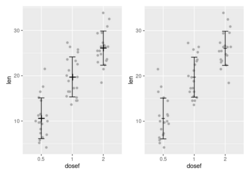
- Can ggplot2 do this? https://www.nature.com/articles/nature25173/figures/1
- plotCI() from the plotrix package or geom_errorbar() from ggplot2 package
- Vertical error bars
- Horizontal error bars
- Horizontal panel plot example and more
- R does not draw error bars out of the box. R has arrows() to create the error bars. Using just arrows(x0, y0, x1, y1, code=3, angle=90, length=.05, col). See
- Building Barplots with Error Bars. Note that the segments() statement is not necessary.
- https://www.rdocumentation.org/packages/graphics/versions/3.4.3/topics/arrows
- Toy example (see this nature paper)
set.seed(301)
x <- rnorm(10)
SE <- rnorm(10)
y <- 1:10
par(mfrow=c(2,1))
par(mar=c(0,4,4,4))
xlim <- c(-4, 4)
plot(x[1:5], 1:5, xlim=xlim, ylim=c(0+.1,6-.1), yaxs="i", xaxt = "n", ylab = "", pch = 16, las=1)
mtext("group 1", 4, las = 1, adj = 0, line = 1) # las=text rotation, adj=alignment, line=spacing
par(mar=c(5,4,0,4))
plot(x[6:10], 6:10, xlim=xlim, ylim=c(5+.1,11-.1), yaxs="i", ylab ="", pch = 16, las=1, xlab="")
arrows(x[6:10]-SE[6:10], 6:10, x[6:10]+SE[6:10], 6:10, code=3, angle=90, length=0)
mtext("group 2", 4, las = 1, adj = 0, line = 1)
- Forest plot example using geom_errorbarh()
geom_rect(), geom_bar()
- https://ggplot2.tidyverse.org/reference/geom_tile.html
- https://plotly.com/ggplot2/geom_rect/, https://ggplot2.tidyverse.org/reference/aes_colour_fill_alpha.html
Note that we can use scale_fill_manual() to change the 'fill' colors (scheme/palette). The 'fill' parameter in geom_rect() is only used to define the discrete variable.
ggplot(data=) +
geom_bar(aes(x=, fill=)) +
scale_fill_manual(values = c("orange", "blue"))
geom_raster() and geom_tile()
- Rectangles. This is useful for creating heatmaps; .e.g DoHeatmap() & an example in Seurat.
- Wordle Words and Expected Value
Waterfall plot
- https://en.wikipedia.org/wiki/Waterfall_chart. A waterfall chart is a type of chart that represents how an initial value is affected by a series of intermediate positive or negative values.
- Understanding Waterfall Plots
- Waterfall charts in ggplot2 with waterfalls package
- ggplot2: Waterfall Charts geom_rect()
- Waterfall Charts in Oncology Trials - Ride the Wave. Drug response
- Collected data is compared to the data taken at baseline to determine if drug has some activity or not. Also each patient is assigned in to different categories based on overall response
- Y-axis = % of change from baseline in the tumor size for each patient
- We want to create this plot by grouping different patients based on their overall response category (eg 'Earth Death' or 'Complete Response') and fill the bars of such patients with different colors so it is easy to identify different groups.
- A waterfall plot for drug BYL719 and color it based on the mutation status of the CDK13 gene, see Xeva vignette.
geom_linerange
- https://ggplot2.tidyverse.org/reference/geom_linerange.html
- A plot of genes on chromosomes. Since ggplot() is inside a function, we need to add print() in order to show the plot.
- See also Given the human gene TP53, retrieve the human chromosomal location of this gene and also retrieve the chromosomal location and RefSeq id of its homolog in mouse from the biomaRt package's vignette.
- Get gene location from gene symbol and ID
- Genomic coordinates to gene lists and vice versa — Annotating gene coordinates and gene lists
- Genomic coordinates of HGNC gene names where org.Hs.eg.db and TxDb.Hsapiens.UCSC.hg19.knownGene are used
- TxDb: Genes, Transcripts, and Genomic Locations which uses a gtf file and the GenomicFeatures package
Circle
Circle in ggplot2 ggplot(data.frame(x = 0, y = 0), aes(x, y)) + geom_point(size = 25, pch = 1)
Annotation
Add a horizontal/vertical line
geom_hline(yintercept=1000) geom_vline(xintercept=99)
text annotations, annotate() and geom_text(): ggrepel package
- ggrepel package, ?geom_text_repel. Found on Some datasets for teaching data science by Rafael Irizarry.
p <- ggplot(dat, aes(wt, mpg, label = car)) + geom_point(color = "red") p1 <- p + geom_text() + labs(title = "geom_text()") # Bad p2 <- p + geom_text_repel(seed=1) + labs(title = "geom_text_repel()") # Good # Use 'seed' to fix the location of textNote that we may need to add show.legend = FALSE in geom_text_repel() to get rid of "a" character in the legend. See Remove 'a' from legend when using aesthetics and geom_text
- Annotations from the chapter Graphics for communication of R for Data Science by Grolemund & Hadley
- ggplot2 texts : Add text annotations to a graph in R software. The functions geom_text() and annotate() can be used to add a text annotation at a particular coordinate/position.
- https://ggplot2-book.org/annotations.html
annotate("text", label="Toyota", x=3, y=100) annotate("segment", x = 2.5, xend = 4, y = 15, yend = 25, colour = "blue", size = 2) geom_text(aes(x, y, label), data, size, vjust, hjust, nudge_x) - Text annotations in ggplot2
p + geom_text(aes(x = -115, y = 25, label = "Map of the United States"), stat = "unique") p + geom_label(aes(x = -115, y = 25, label = "Map of the United States"), stat = "unique") # include border around the text - Use the nudge_y parameter to avoid the overlap of the point and the text such as
ggplot() + geom_point() + geom_text(aes(x, y, label), color='red', data, nudge_y=1) - What do hjust and vjust do when making a plot using ggplot? 0 means left-justified 1 means right-justified. This is necessary if we have multiples lines in text. By default, it will center-justified.
- Volcano plots, EnhancedVolcano package
- Visualization of Volcano Plots in R
Text wrap
ggplot2 is there an easy way to wrap annotation text?
p <- ggplot(mtcars, aes(x = wt, y = mpg)) + geom_point()
# Solution 1: Not work with Chinese characters
wrapper <- function(x, ...) paste(strwrap(x, ...), collapse = "\n")
# The a label
my_label <- "Some arbitrarily larger text"
# and finally your plot with the label
p + annotate("text", x = 4, y = 25, label = wrapper(my_label, width = 5))
# Solution 2: Not work with Chinese characters
library(RGraphics)
library(ggplot2)
p <- ggplot(mtcars, aes(x = wt, y = mpg)) + geom_point()
grob1 <- splitTextGrob("Some arbitrarily larger text")
p + annotation_custom(grob = grob1, xmin = 3, xmax = 4, ymin = 25, ymax = 25)
# Solution 3: stringr::str_wrap()
my_label <- "太極者無極而生。陰陽之母也。動之則分。靜之則合。無過不及。隨曲就伸。人剛我柔謂之走。我順人背謂之黏。"
p <- ggplot() + geom_point() + xlim(0, 400) + ylim(0, 300) # 400x300 e-paper
p + annotate("text", x = 0, y = 200, hjust=0, size=5,
label = stringr::str_wrap(my_label, width =30)) +
theme_bw () +
theme(panel.grid.major = element_blank(),
panel.grid.minor = element_blank(),
panel.border = element_blank(),
axis.title = element_blank(),
axis.text = element_blank(),
axis.ticks = element_blank())
ggtext
ggtext: Improved text rendering support for ggplot2
ggforce - Annotate areas with ellipses
Other geoms
Exploring other {ggplot2} geoms
geomtextpath
geomtextpath- Create curved text in ggplot2
Build your own geom
Fonts, icons
- Adding Custom Fonts to ggplot in R
- The {showtext_auto} function from {showtext} supports a large collection of font formats and graphics devices!
- Using different fonts with ggplot2
- How to use Fonts and Icons in ggplot
Lines of best fit
Save the plots -- ggsave()
ggsave(). Note svglite package is required, see R Graphics Cookbook. The svglite package provides more standards-compliant output.
By default the units of width & height is inch no matter what output formats we choose.
(3/24/2022) If I save the plot in the svg format using RStudio GUI (Export -> As as Image...) or by the svg() function, the svg plot can't be converted to a png file by ImageMagick. But if I save the plot by using the ggsave() command, the svg plot can be converted to a png file.
$ convert -resize 100% Rerrorbar.svg tmp.png convert-im6.q16: non-conforming drawing primitive definition `path' @ error/draw.c/RenderMVGContent/4300. $ convert -resize 100% Rerrorbar2.svg tmp.png # Works
(1/31/2022) For some reason, the text in legend in svg files generated by ggsave() looks fine in browsers but when I insert it into ppt, the word "Sensitive" becomes "Sensitiv e". However, the svg files generated by svg() command looks fine in browsers AND in ppt.
ggsave() will save a plot with the width/height based on the current graphical device if we don't specify them. That's why after we issue ggsave() it will tell us the image size (inch). So in order to have a fixed width/height, we need to specify them explicitly. See
My experience is ggsave() is better than png() because ggsave() makes the text larger when we save a file with a higher resolution.
...
ggsave("filename.png", object, width=8, height=4)
# vs
png("filename.png", width=1200, height=600)
...
dev.off()
We can specify dpi to increase the resolution if we use the png format (svg is not affected); see Chapter 14.5 Outputting to Bitmap (PNG/TIFF) Files from R Graphics Cookbook.
g1 <- ggplot(data = mydf)
g1
ggsave("myfile.png", g1, height = 7, width = 8, units = "in", dpi = 300)
I got an error - Error in loadNamespace(name) : there is no package called ‘svglite’. After I install the package, everything works fine.
ggsave("raw-output.bmp", p, width=4, height=3, dpi = 100)
# Will generate 4*100 x 3*100 pixel plot
Note:
- For saving to "png" file, increasing dpi (from 72 to 300) will increase font & point size. dpi/ppi is not an inherent property of an image.
- If we don't specify any parameters and without resizing the graphics device size, then "png" file created by ggsave() will contain much more pixels compared to "svg" file (e.g. 1200 vs 360).
- How ggsave() decides width/height if a svg file was used in an Rmd file? A: 7x7 from my experiment. So the font/point size will be smaller compared to a 4x4 inch output.
- When I created an svg file in Linux with 4x4 inch (width x height), the file is 360 x 360 pixels when I right click the file to get the properties of the file. But macOS cannot return this number nor am I able to find this number from the svg file??
Multiple pages in pdf
https://stackoverflow.com/a/53698682. The key is to save the plot in an object and use the print() function.
pdf("FileName", onefile = TRUE)
for(i in 1:I) {
p <- ggplot()
print(p)
}
dev.off()
graphics::smoothScatter: scatter plots with lots of points
- ?smoothScatter
- Smooth scatter plot in R
- smoothScatter with ggplot2
- An example from DeMixT. As we can see, we can we the lines() or abline() to add lines.
Other tips/FAQs
Tips and tricks for working with images and figures in R Markdown documents
Ten Simple Rules for Better Figures
Ten Simple Rules for Better Figures
Recreating the Storytelling with Data look with ggplot
Recreating the Storytelling with Data look with ggplot
ggplot2 does not appear to work when inside a function
https://stackoverflow.com/a/17126172. Use print() or ggsave(). When you use these functions interactively at the command line, the result is automatically printed, but in source() or inside your own functions you will need an explicit print() statement.
BBC
- bbplot package from github, How to customize ggplot with bbplot
- BBC Visual and Data Journalism cookbook for R graphics from github
- How the BBC Visual and Data Journalism team works with graphics in R
Add your brand to ggplot graph
You Need to Start Branding Your Graphs. Here's How, with ggplot!
Animation and gganimate
- https://gganimate.com/
- Animating Changes in Football Kits using R: rvest, tidyverse, xml2, purrr & magick
- Animated Directional Chord Diagrams tweenr & magick
- x-mas tRees with gganimate, ggplot, plotly and friends
- Create animation in R: learn by examples (gganimate)
- The USMS ePostal Over the Last 20+ Years (gganimate and bar charts)
- R tip: Animations in R from IDG TECHtalk
ggstatsplot
ggstatsplot: ggplot2 Based Plots with Statistical Details
Write your own ggplot2 function: rlang
Some packages depend on ggplot2
dittoSeq from Bicoonductor
Meme
Python
plotnine: A Grammar of Graphics for Python.
plotnine is an implementation of a grammar of graphics in Python, it is based on ggplot2. The grammar allows users to compose plots by explicitly mapping data to the visual objects that make up the plot.
